| 1 | Local Herbs Day II: Healthy Eating with a Touch of Herbs
Date:7 April 2018
Venue: UTAR, Kampar Campus
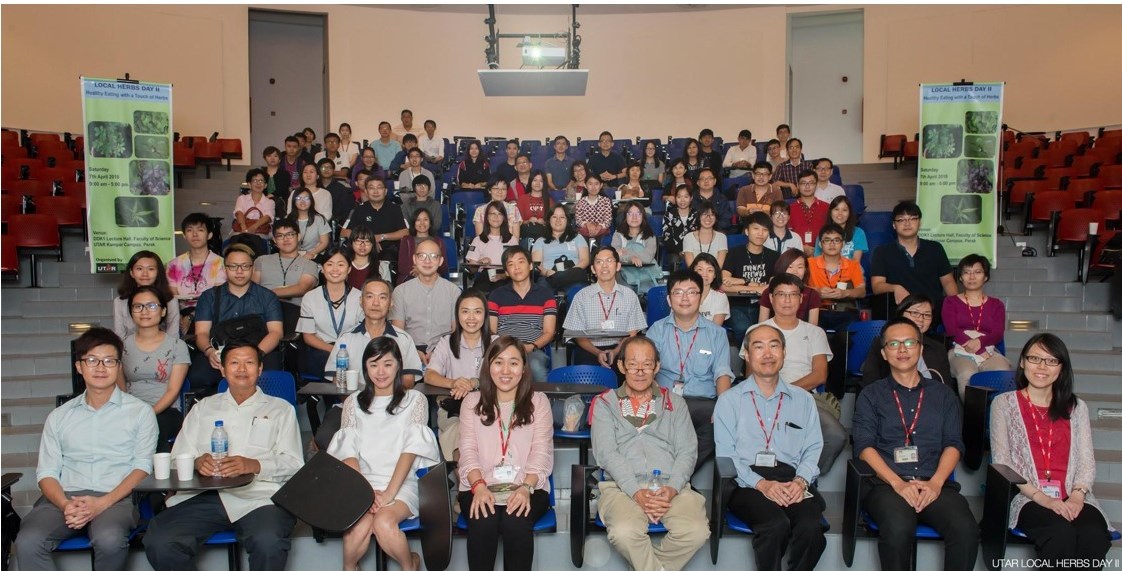
A group photo of the organising committee, speakers and participants
UTAR Centre for Bio-Diversity Research (CBR), Faculty of Science (FSc) and Institute of Postgraduate Studies and Research (IPSR) jointly organised the “Local Herbs Day II: Healthy Eating with a Touch of Herbs”. It was held at UTAR Kampar Campus on 7 April 2018.
The event aimed to facilitate knowledge sharing and provide exposure on the culinary uses of local herbs among the community as well as the students and staff of the University. More than 80 participants from within and outside the campus attended the event.
In her welcoming remarks, Organising Chairperson Dr Teh Lai Kuan said, “The use of herbs has become more common in our daily lives. We choose to use herbs because they are effective, safe and cost-effective complements or alternatives to pharmaceutical drugs. Also, for health maintenance. With the proper use of local herbs, our lives will definitely be changed in the best way possible. Besides that, I would like to take this opportunity to thank the organising committee for their hard work and the sponsors for making this event a success.”

CBR Chairperson Dr Wong Wey Lim delivering a token of appreciation to Dr Teh
A talk was held after the opening ceremony and it was divided into three sessions. The first talk was conducted by Clinical Dietitian-cum- Head of BioMedical Science Department of FSc Dr Chee Huei Phing on “Role of Herbs in Healthy Eating – from dietitian’s perspective”. The second talk was conducted by Dr Teh on “Cooking with five elements (五行) – from Chinese physician’s perspective” and the third talk was conducted by Nutritionist Vanessa Lim Chew Siang on “Herbs in weight management – from nutritionist’s perspective”.
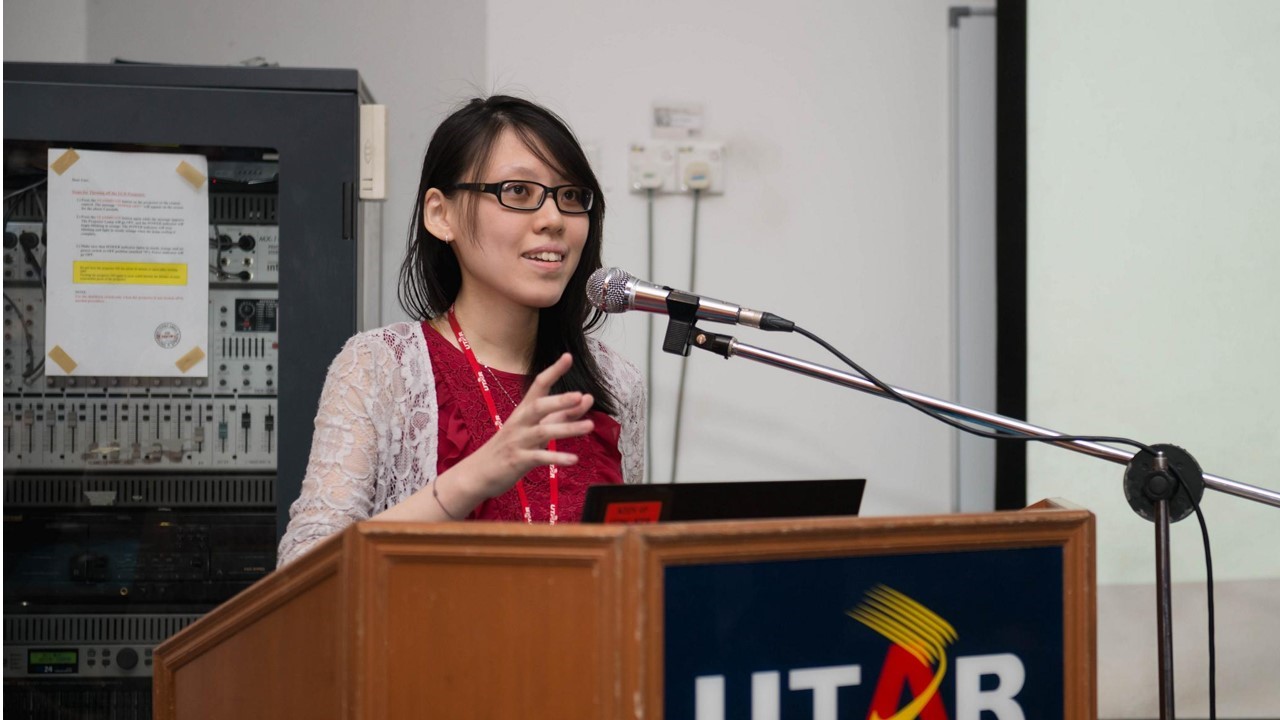
Dr Chee sharing about the role of herbs
Dr Chee has been actively involved in consulting and providing dietary advice to patients in the cardiology, diabetes, geriatric, renal, liver, oncology, intensive care unit, gastrointestinal and paediatric cases at government hospitals as well as community setting before she joined UTAR. From the dietitian’s perspective, she elaborated on the basic principle and the common practice of healthy eating such as having a regular meal time, observing daily calories intake and making wise food choices. She also talked about the role of herbs in healthy eating and said, “We can usually use herbs instead of food additives in our cooking because foods with herbs will enhance the flavour and aroma of the food. Reducing the intake of food additives will help one to scale down health risks. However, further scientific research is needed to make clinical recommendations regarding the health effects of specific herbs.” She also explained the usage of herbs such as stevia extract and cinnamon for diabetic patients, garlic for hypertensive patients, and precaution matters for patients with chronic kidney disease (CKD).
Moreover, she introduced the Traditional and Complementary Medicine Blueprint 2018-2027 (Health Care) which was launched by the Ministry of Health and the Traditional and Complementary Medicine Unit in certain government hospitals. The talk gained an active response from the participants.
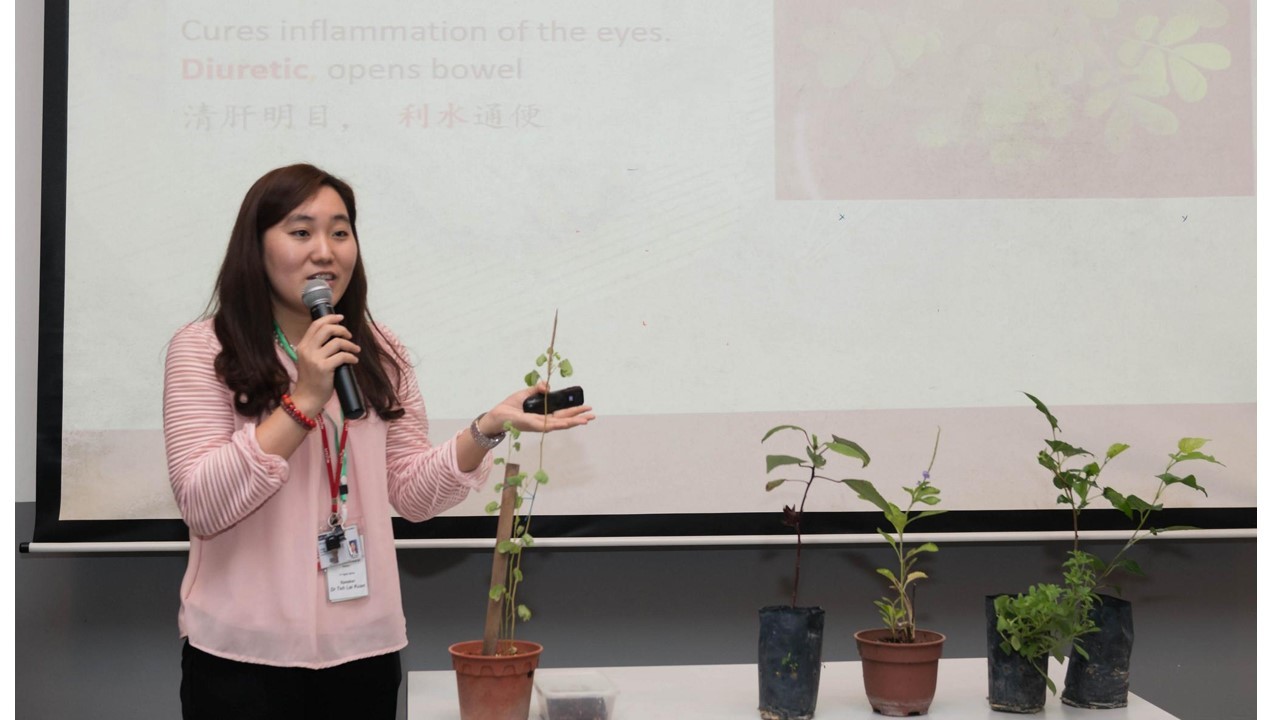
Dr Teh introducing the benefits of several herbs
Dr Teh is a registered practicing Chinese physician and a life member of the Malaysian Acupuncturists Association and Academic of Traditional Chinese Medicine Kuala Lumpur and Selangor. Dr Teh introduced the “five elements”, a very useful dietary theory in Traditional Chinese Medicine (TCM). It consists of wood (木), fire (火), earth (土), metal (金) and water (水). According to Dr Teh, the five elements represent the physiological functions of the five main organs, namely liver, heart, spleen, lung and kidney. The liver (wood) represents the circulatory system and the blood storage; heart (fire) represents the cardiovascular system; spleen (earth) represents the digestive system; lung (metal) represents the respiratory system; and kidney (water) represents the urinary system. She also mentioned that flavours (sour, bitter, sweet, umami and salty) and colours (green, red, yellow, white and black) of food are also used to represent the five elements respectively. She emphasised, “There is interrelationship among these five elements and balance must be kept in order to maintain the health of an individual. By understanding the patterns of disharmony and imbalances in the body, suitable food can be selected to help enhance an individual’s overall health.”
She then shared about the elements and application of some common and useful herbs, such as Morus sp (mulberry tree), Cassia obtusifolia L., Stachytarpheta jamaicensis (L) Vahl, Stevia rebaudiana (sweet leaf) and Hibiscus sabdariffa (roselle) to provide the participants with the basic knowledge of herbs according to the dietary theory in TCM.

Lim revealing the role of herbs in weight management
Vanessa Lim is the owner of V Consultant Enterprise and has been working as a nutritionist for 10 years. She serves as the programme’s nutrition consultant. She was invited as guests for various health shows in ntv7, 8tv, Astro and Media Prima. She began by sharing the experience of recuperating her father’s kidney disease by using local herbs and also a few cases of her patients who cured their illness by using natural foods or ingredients in their daily meal. She shared about some herbs that will improve health, the difference between dried and fresh herbs, herbs for proper weight management, how to improve the nutritional value of herbs , herbs proven to help lose weight, daily herb intake and the suitability of herb intake.
According to Lim, the eight local herbs proven to help lose weight, such as wormwood, lemon grass, ginger, turmeric, garlic, onion, pepper and pandan leaves, are common, easily accessible and effective. In the talk, she also shared about some herbs for weight management based on her recipe, such as wormwood egg, nasi lemak sambal and whole grains paste.
The afternoon session was on “The response of certain local herbs toward nicotine” by a Chinese physician from FIG Enterprise Chan Chew Chok. Chan has more than 70 years of experience in herbs plantation. Before starting his demonstration, he introduced several medicinal herbs that were beneficial to humans such as fig, Randia spinosa and Dioscorea Bulbifera. FIG Enterprise sponsored fig drinks and their published TCM book to the participants.
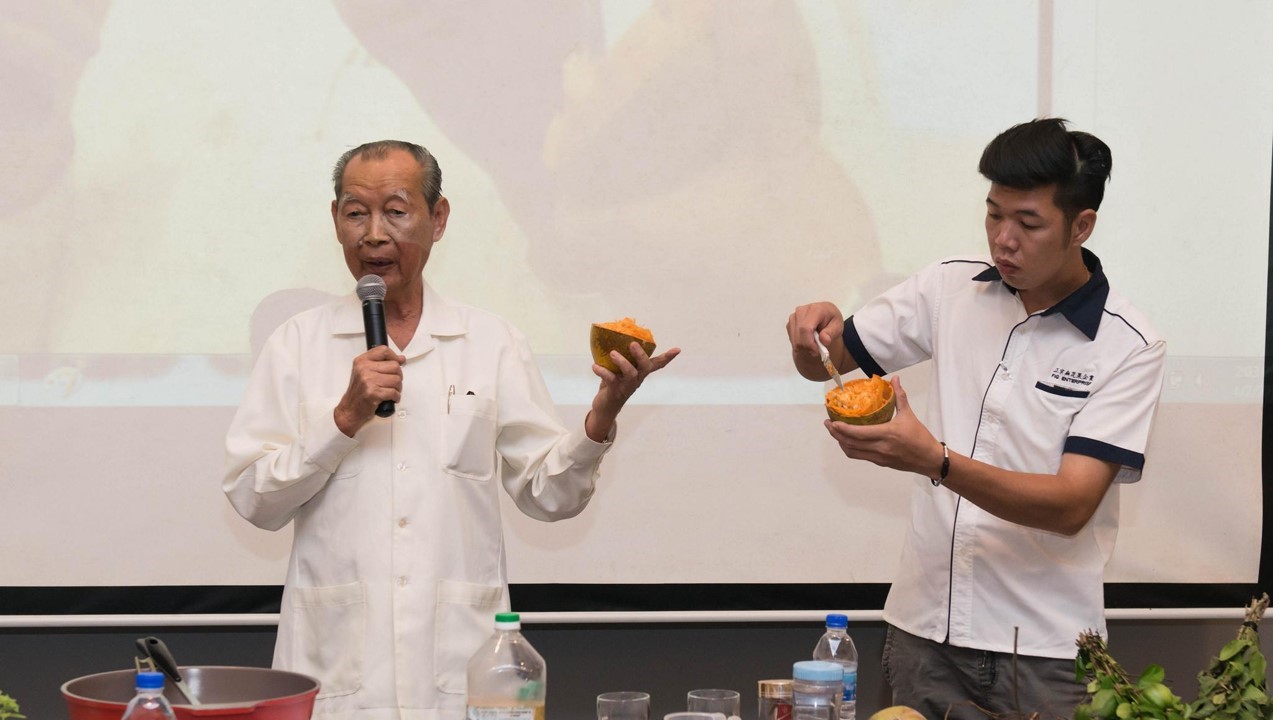
Chan (left) showing the participants how figs look like
Following were cooking demonstration sessions on the making of “Murungai Adai”, a healthy and gluten-free flat bread breakfast recipe by Department of Biomedical Science lecturer Annaletchumy Loganathan; a recipe on how to soothe cough with ginger and licorice - DIY cough drops by Department of Agricultural and Food Science lecturer Sim Kheng Yuen; Basil and Oregano Stir-fry Spaghetti, a herbal and spice infused pasta by Department of Agricultural and Food Science lecturer Chung Kok Heung; and Chicken Biscuit, a favourite snack of valuable herbs (cekor) by Department of Biomedical Science Dr Tan Gim Cheong and his team. Apart from gaining more understanding about the herbs, the participants also had the opportunity to taste the food they have prepared in each session.
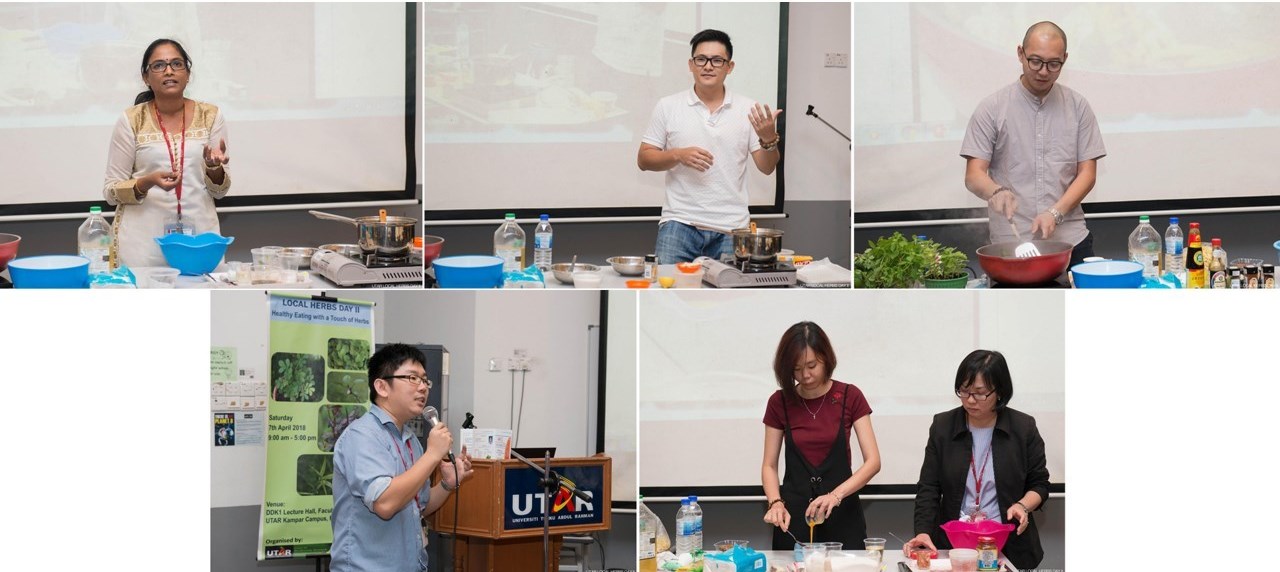
Clockwise from top left: Annaletchumy, Sim, Chung, and Dr Tan with his team members
In his closing remarks, FSc Dean Assoc Prof Dr Lim Tuck Meng expressed his gratitude to the organising committee, speakers, sponsors and participants for their support. He also introduced the establishment of FSc and the highlighted programmes and events of the faculty. “University exists to create and share knowledge with the society. FSc started in the year 2009 and we have established many new programmes ever since to produce manpower to the society,” he said. He encouraged the participants to share the knowledge and said, “Learning is a lifelong process, and whatever we have learned, if it is useful to ourselves and other people, we should share the knowledge so that the society and other people will grow to become better.”
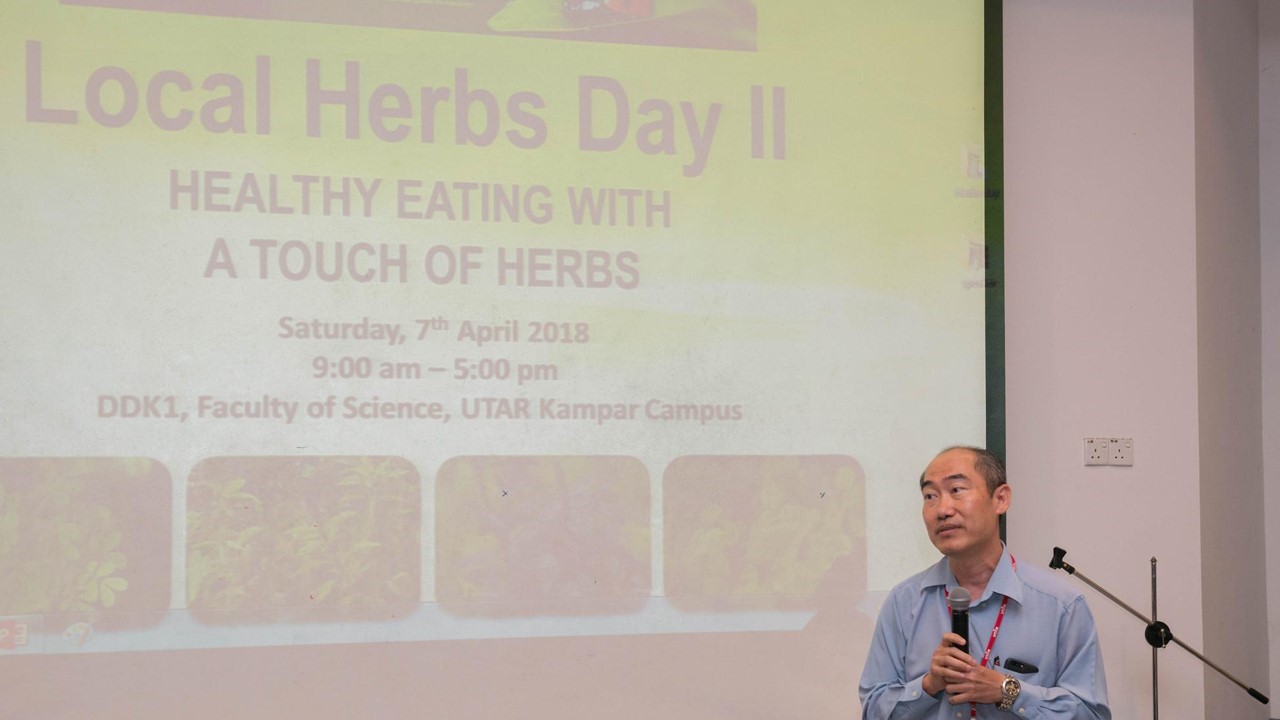
Dr Lim delivering his closing remarks
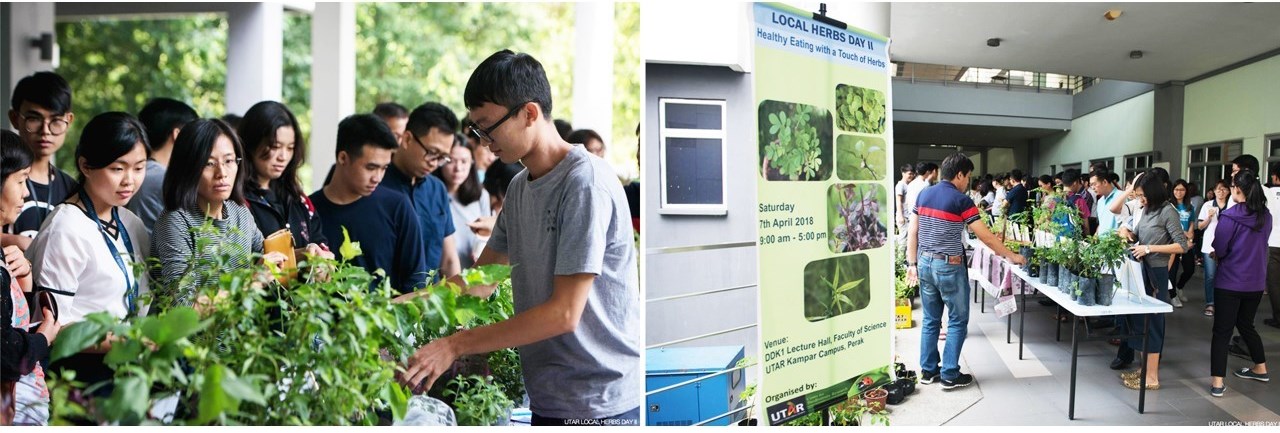
The participants learning about the herbs through the exhibition

A group photo of student helpers from the Agriculture and Food Science Society after the seminar
|
| 2 |
Agriculture Technology (AgriTech) Seminar Series XVII
Date: 7 July 2018
Venue: UTAR, Kampar Campus
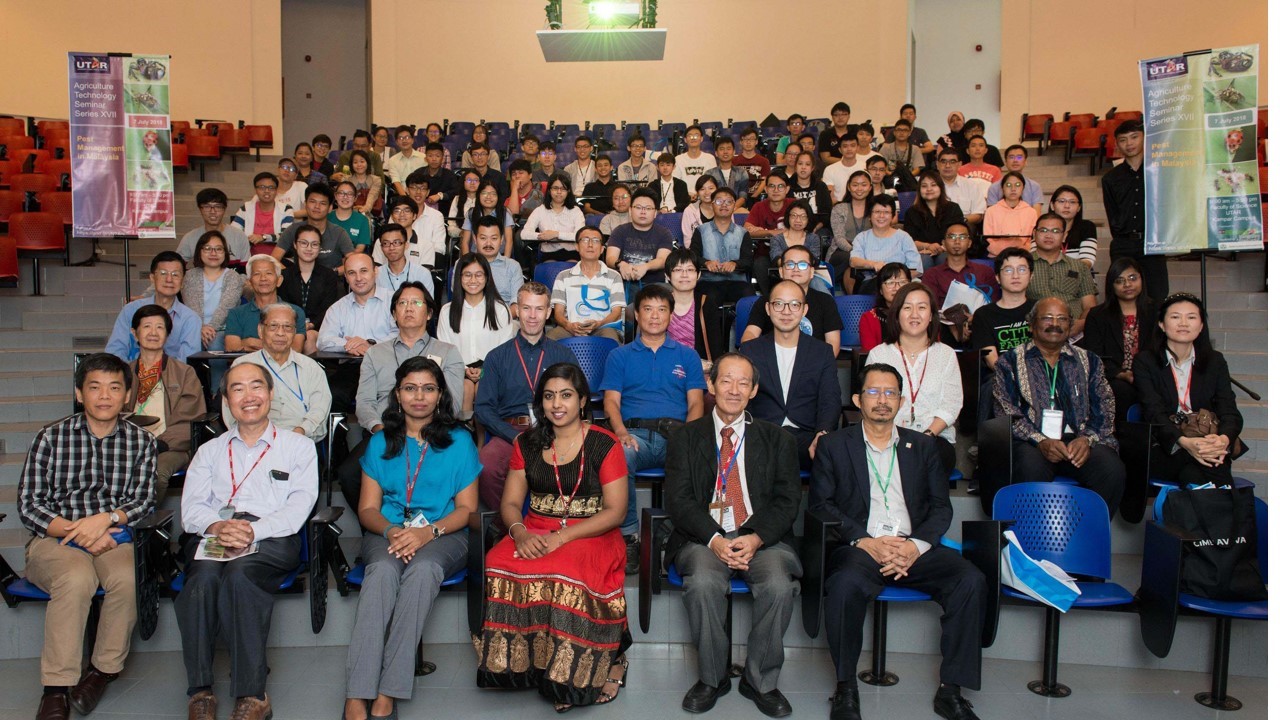
Speakers, organising committee and participants of the seminar
Held for the 17th time, the Agriculture Technology (AgriTech) Seminar Series took place on 7 July 2018 at Kampar Campus. It was co-organised by the Centre for Biodiversity Research (CBR), Faculty of Science (FSc) and Institute of Postgraduate Studies and Research (IPSR).
This year’s seminar noted the importance of increasing the agricultural production to meet the growing global demands. Hence the theme ‘Pest Management in Malaysia’ aimed to address the reduction of agricultural yield caused by pests. The seminar also aimed to expand the knowledge of scientists, farmers and industry players via discussions on the use of chemicals for pest control, criteria to choose the right pest control measures and ways to produce safe foods for the consumers.
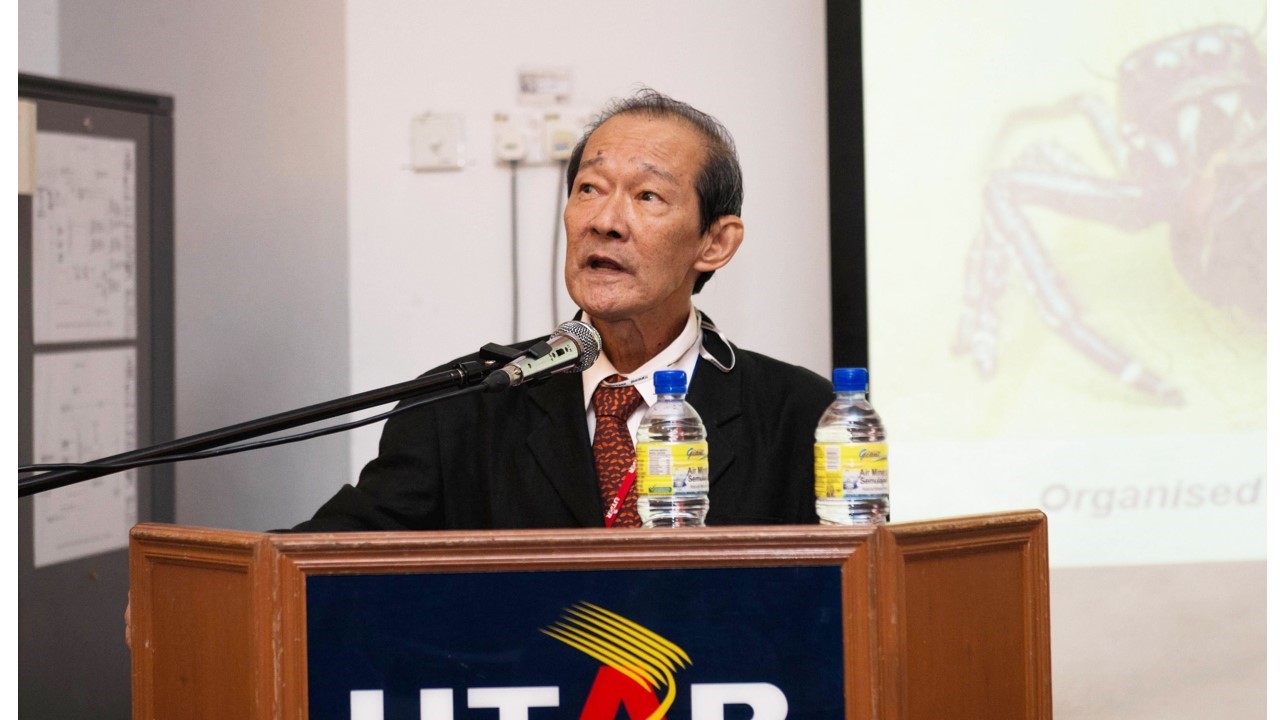
Prof Ooi delivering his speech
Organising Chairperson Prof Dr Peter Ooi Aun Chuan, in his welcome speech, emphasised the need for citizens to have a better understanding on pest management while ensuring that the environment stays protected and is able to produce healthy food for the consumers. He stressed for ongoing researches and continuous learning to be conducted on pest management. He also highlighted that having sufficient understanding of this issue will help to promote sustainable agriculture. He then thanked the speakers for sharing their knowledge and experiences.
Prof Ooi, who was also the first speaker for the morning session, shared the “Overview of Pest Management in Malaysia”, and elaborated on the two major causes of outbreaks of insect pest in Malaysia. He exemplified the first cause with the outbreak that severely affected an oil palm in the 1950s. Due to the outbreak, a British Entomologist was hired to study the causes of the outbreaks and the results concluded that highly toxic insecticides were the cause for the pest outbreak. As a result, toxic insecticides were restricted from oil palm estates and that encouraged the natural enemies of the pests to do their jobs. The second cause was reflected in the case of the diamond-backed moth in Cameron Highlands. He explained the seriousness of the insecticide resistance, which led to two parasitoids being introduced from New Zealand. From the second incident, participants learnt that organic farming of crucifer was possible in the highlands.
Following that, Moderator Academician Emeritus Prof Dr Yong Hoi Sen introduced the second speaker, Biological Research Department Director of Malaysian Palm Oil Board (MPOB) Dr Norman Hj Kamarudin to present his research titled “Sustainable Management on Oil Palm Pests and Diseases in Malaysia”. On noting that bagworms, rhinoceros beetle, bunch moth and termites are among the major insect pests in oil palms, he explained that sustainable management of the insect pests with long-term effects is now practised by most plantations. He elucidated that integrated pest management (IPM) approach of census and detection followed by the application of Bacillus thuringiensis or selective pesticides, planting of beneficial plants for natural enemies and mass trapping could possibly reduce the population of bagworms without endangering the environment.
The participants also learnt that during replanting, good agricultural practices, such as planting of cover crops, proper management of biomass residues and the use of microbes such as Metarhizium have been practised successfully to control rhinoceros beetle. MPOB has also introduced the Integrated Ganoderma Management (IGM) to find the solution for the disease which includes sanitation, biological control, fertiliser with beneficial (trace) elements and chemical control. He emphasised that increase efforts in these areas would ensure better management of pests and disease for a sustainable and long-term control of pest and diseases in oil palm.
The third speaker, Centre for Agriculture and Biosciences International (CABI) Regional Director Dr Sivapragasam Annamalai, presented his research titled “Integrated Pest Management: Regional Experiences in Southeast Asia”, which broadly examines the nexus between agricultural production in Southeast Asia (sea), the role of pesticides and IPM.
He explained that IPM focuses on biological control as its core component and has largely served as an important tactical approach against the indiscriminate use of pesticides. It was understood that the approach had fulfilled the needs of the farming community in SEA in a number of pesticide-induced environments such as pest outbreaks. Despite the numerous IPM endeavours, Dr Sivapragasam highlighted that there are major challenges that remain to be addressed. The challenges he listed included inadequate problem definition leading to poor project design, inappropriate research which fails to design technologies suited to small farmers, fragmentation of effort within a country and ill-suited government policies which favour pesticide use.
The afternoon session saw Moderator Dr Tan Swee Lian introducing the fourth speaker, Technical Manager for Koppert Biological Systems, Netherlands Dr Bart de Graaf, who presented on “Integrated Pest Management”.
He discovered that throughout the agricultural sector in Malaysia, the disproportionate use of agro-chemical leads to widespread pollution of the natural environment and puts farmers’ and farm workers’ health at risks. He suggested using IPM as one of the solutions. He then elaborated on the definition of IPM and the components of the system that claim to make agriculture healthier and more sustainable. He also spoke about the benefits of IPM for the growers and reasons for growers to adopt IPM. He highlighted that one of the major factors in the success of IPM is biological control, which is using natural enemies to help growers reduce the amount of agro-chemicals significantly.
Speaker and FSc lecturer Dr Ong Ching Ang presented the “Overview of Management of Plant Pathogens in Malaysia”, which highlighted the need to maintain the balance of nature, more specifically the sustainability of agriculture while managing plant pathogens in the agroecosystem.
He enlightened the participants with the three broad approaches that were used to manage plant pathogens, namely environmental manipulations, host manipulations and pathogen manipulations. His presentation also reviewed some local examples of the management of viruses Chilli veinal mottle virus and Rice tungro virus complex; bacterium Candidatus Liberibacter asiaticus [hualongbing]; and fungus Microcyclus ulei [South American leaf blight].
The final speaker Entomologist and Agronomist of Advanced Agriecological Research Sdn Bhd Dr Teo Tze Min, presented her research titled “R&D Activities in Pest Management”. Her focus is to research for safer chemicals and alternative ways of controlling pest populations. She also mentioned that understanding the population dynamics in the agriecosystem is important for effective integrated pest management and that emerging pests are also vigilantly monitored and studied to find effective ways of control.
James Lawrence Teh Cheng Jin, who is a farmer himself, has been attending the seminar series for the past two years. He mentioned that the seminar had enabled him to learn more about farming. “I learnt new things again; I learnt about pathogens and the transmission of diseases. I also gained knowledge to understand pest management. I am able to use the right methods for farming and better understand the risks involved,” said Teh.
Meanwhile, Technical and Sales Executive of Farmcochem Sdn Bhd Lim Jia Yang mentioned that the seminar had enabled him to understand better on the usage of chemicals for pest management, while establishing a good network with other external participants.
The end of the seminar saw FSc Dean Assoc Prof Dr Lim Tuck Meng delivering his closing speech. He thanked all the speakers for sharing their knowledge and also thanked the participants and sponsors for their support towards the seminar.
“I am very happy to see the organising committee being so passionate to continue organising this seminar series. It has become a meeting place for researchers, industry players, students and the public to learn more about agriculture. For the students in particular, I hope they will gain a better understanding and have practical ideas to think about their future career development,” said Dr Lim.
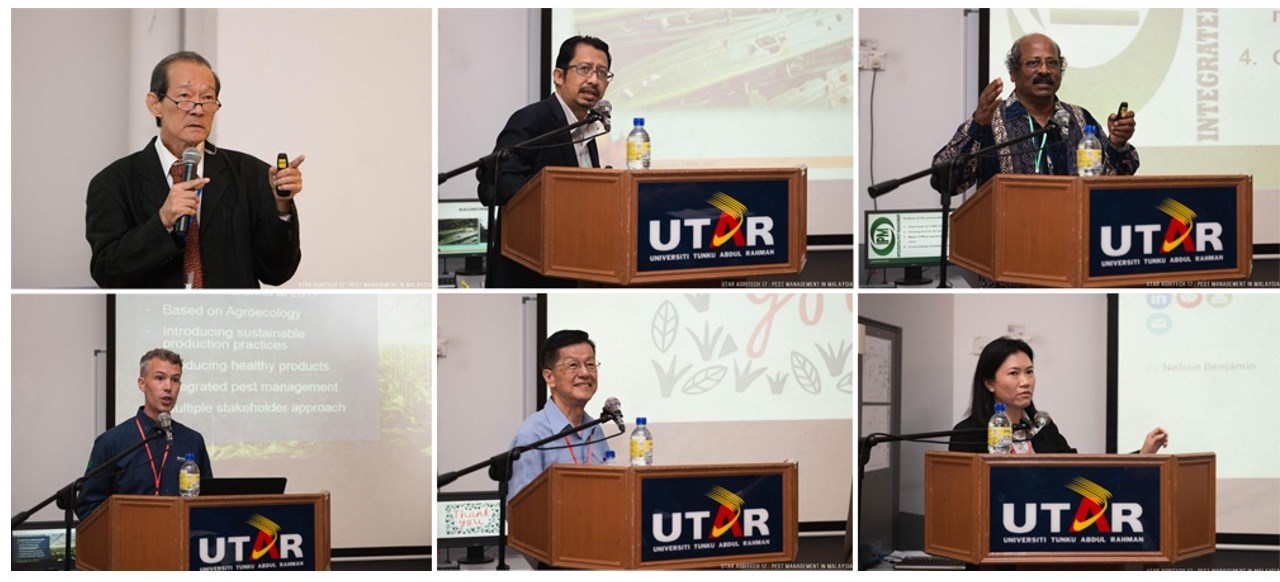
Speakers of the seminar (clockwise from top left): Prof Ooi, Dr Norman, Dr Sivapragasam,
Dr Teo, Dr Ong and Dr Bart
|
| 3 |
International Conference on Tropical Biodiversity 2018
Date: 8 – 11 October 2018
Venue: Tower Regency Hotel, Ipoh
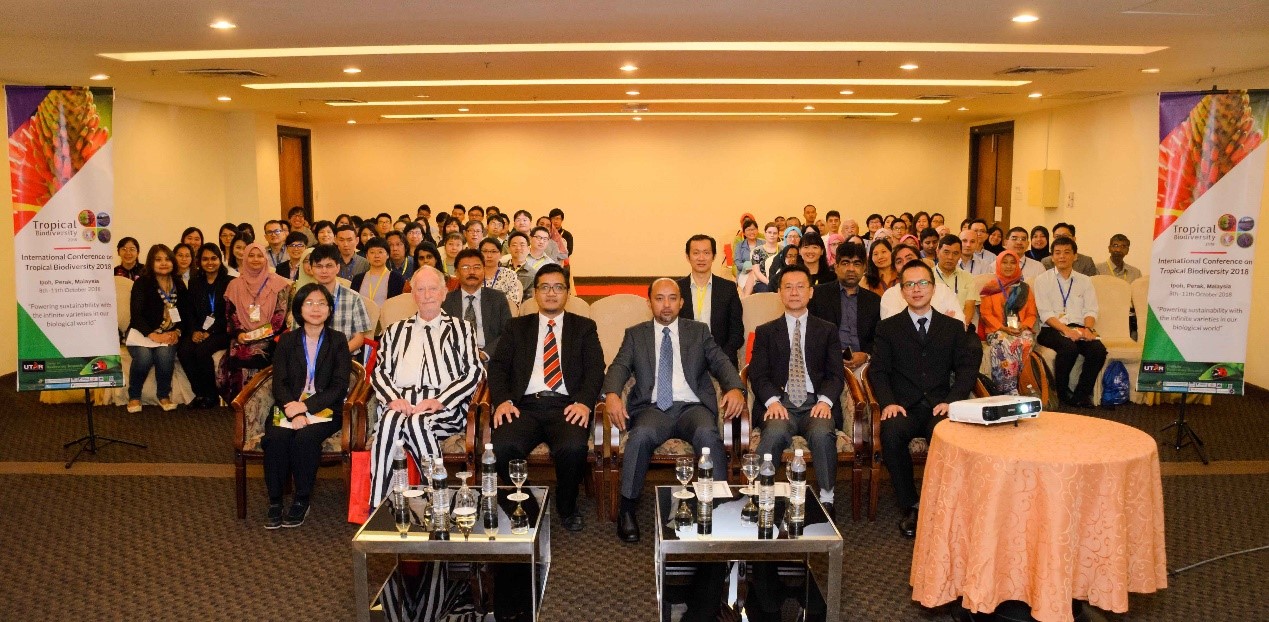
Front row, from left: Dr Goh, Dato Sri Dr Gathorne-Hardy, Prof Faidz, Hizaz, Kok Keong, and Dr Wong, posing with speakers and participants at the opening ceremony
The International Conference on Tropical Biodiversity 2018 was successfully held from 8 to 11 October 2018, at Tower Regency Hotel, Ipoh. The conference was jointly organised by UTAR’s Centre for Biodiversity Research (CBR), South China Botanical Garden (SCBG) (Chinese Academy of Science), Bogor Agricultural University, Society for Conservation Biology, Malaysian Society of Applied Biology, Rimba Ilmu (University of Malaya), Universiti Malaysia Terengganu, University Kuala Lumpur (UniKL) MICET, The University of Nottingham Malaysian Campus, Monash University Malaysia, Yayasan Bina Lestari, and Pulau Banding Foundation.
Present at the opening ceremony were Director of Ministry of Tourism, Arts and Culture Malaysia, Perak office Hizaz bin Mohd Ibrahim, UTAR Vice President for R&D and Commercialisation Prof Ts Dr Faidz bin Abd Rahman, the 5th Earl of Cranbrook Dato Sri Dr Gathorne Gathorne-Hardy, Deputy Chairman of Perak Academy Chan Kok Keong, Chairperson of CBR Dr Wong Wey Lim, and Organising Chairperson Dr Goh Wei Lim.
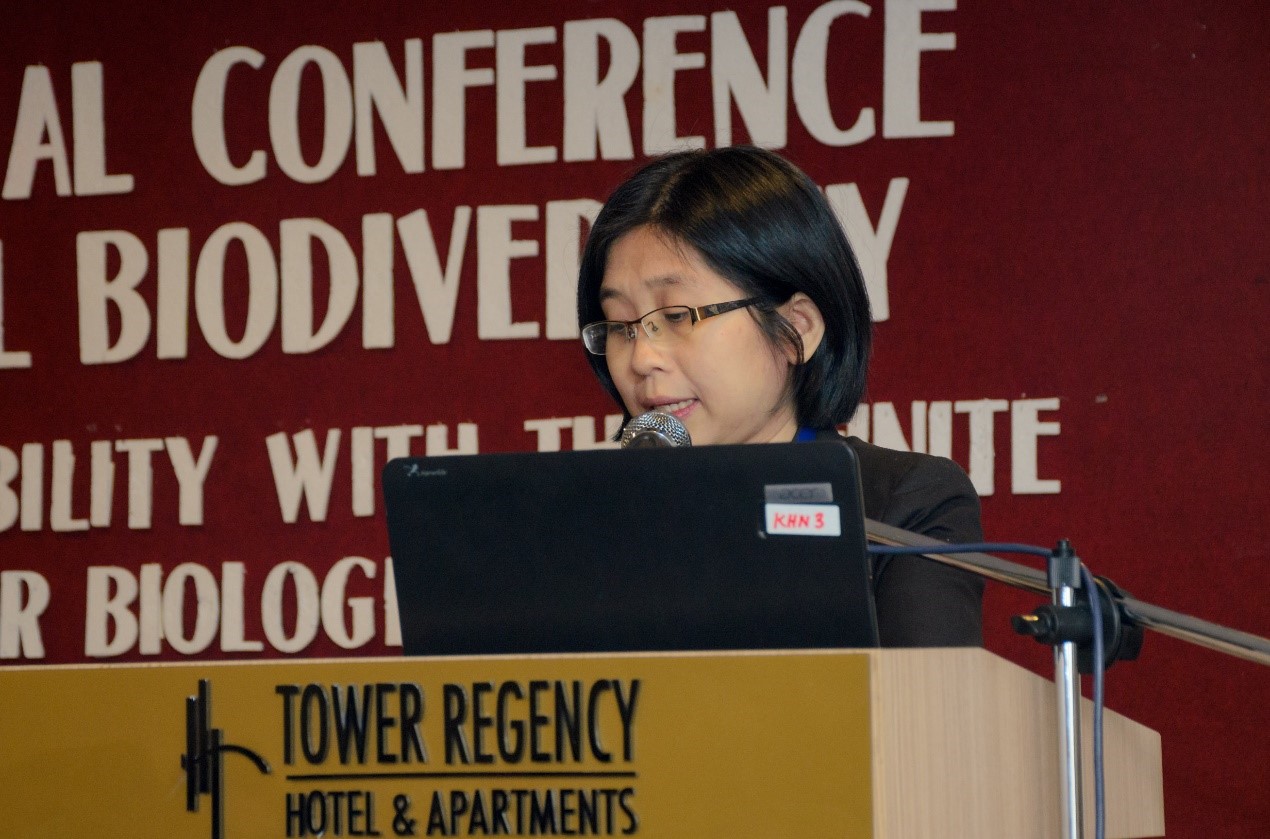
Dr Goh delivering her speech
“This conference is indeed our first ever international biodiversity conference. We believe biodiversity in the biomes leads to the stability of ecosystems. All living things in this world coexist and interacts every day. Only with the right understanding could we manage our ecosystem more sustainably. Scientific research on biodiversity is therefore important for us to gain fundamental knowledge that will benefit us all,” said Dr Goh.
She added, “We are extremely honoured to have various institutions joining us as the co-organiser. The invited speakers we have today here are experts in their respective fields of study. Besides, we are also excited to have participants from China, Indonesia, Singapore, United Kingdom (UK) and local participants joining us. We hope our conference will serve as a platform for us all to exchange research ideas, and to learn from one another.”

Prof Faidz delivering his speech
Appreciating the organising committee for the effort, Prof Faidz mentioned, “I am glad the theme for this conference and the public forum focus on ‘Powering Sustainability with Infinite Varieties in Our Biological World’. As we all know, Malaysia is well known for its mega biodiversity. For instance, the Royal Belum State Park and Temenggor Forest Reserve are notable for harbouring high concentrations of rare species such as Rafflesia the parasitic flower, hornbills, and Malayan tigers. With this conference held in Malaysia, we are able to bring researchers and students from various economies here to jointly discuss, share experience and address current issues related to tropical biodiversity.”
He continued, “I am proud that the Centre for Biodiversity Research has initiated and taken the role in organising the conference together with the co-organisers. This conference is also made possible with thanks to the sponsors, who are Yayasan Hasanah, Perak State Government, Tourism Perak Malaysia, companies, and individuals. I would also like to express my heartiest congratulations to the organising committee for the success in organising this conference. I hope everyone here will be enlightened by the discussion in the conference, and will continue with greater efforts, to understand and conserve the vast biodiversity in our tropical ecosystems.”
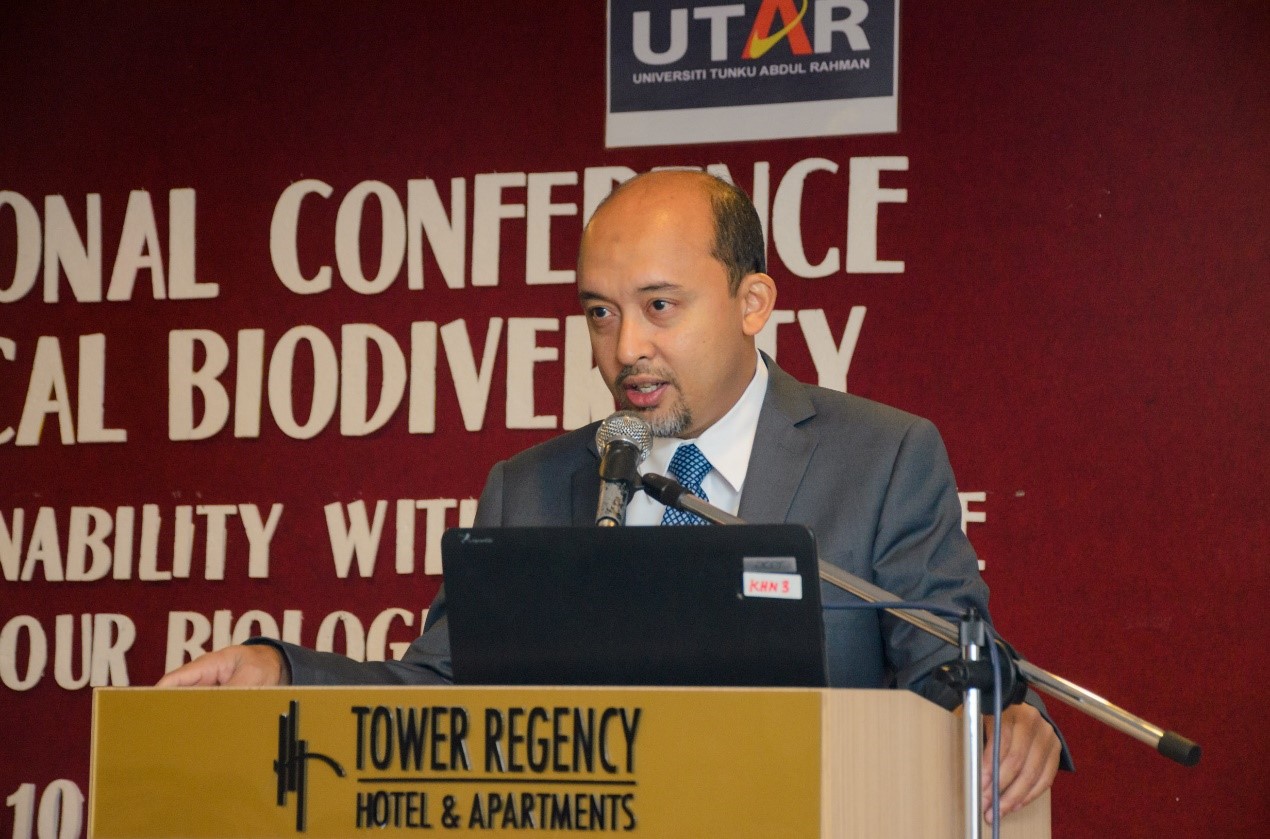
Hizaz explaining the importance of biodiversity to ecotourism in his speech
Meanwhile, Hizaz, in his speech, highlighted on the importance of biodiversity in ecotourism. “Biodiversity is important for ecotourism. It is not only contributing to the country’s economy but also providing different resources for our livelihood, culture, and food security. Unsustainable development for the environment may cause an imbalance to our ecosystem, thus resulting in the loss of many precious biodiversity that are important to our wellbeing. We have to realise that a healthy and sustainable ecosystem is important for our future generation. To mutually support biodiversity and tourism, we have always been sharpening sustainable developments in achieving common goals. This international conference is therefore, timely to discuss on conservation and sustainability of biodiversity, and hopefully to find solutions or methods that will enable humans and nature to live harmoniously,” said Hizaz.
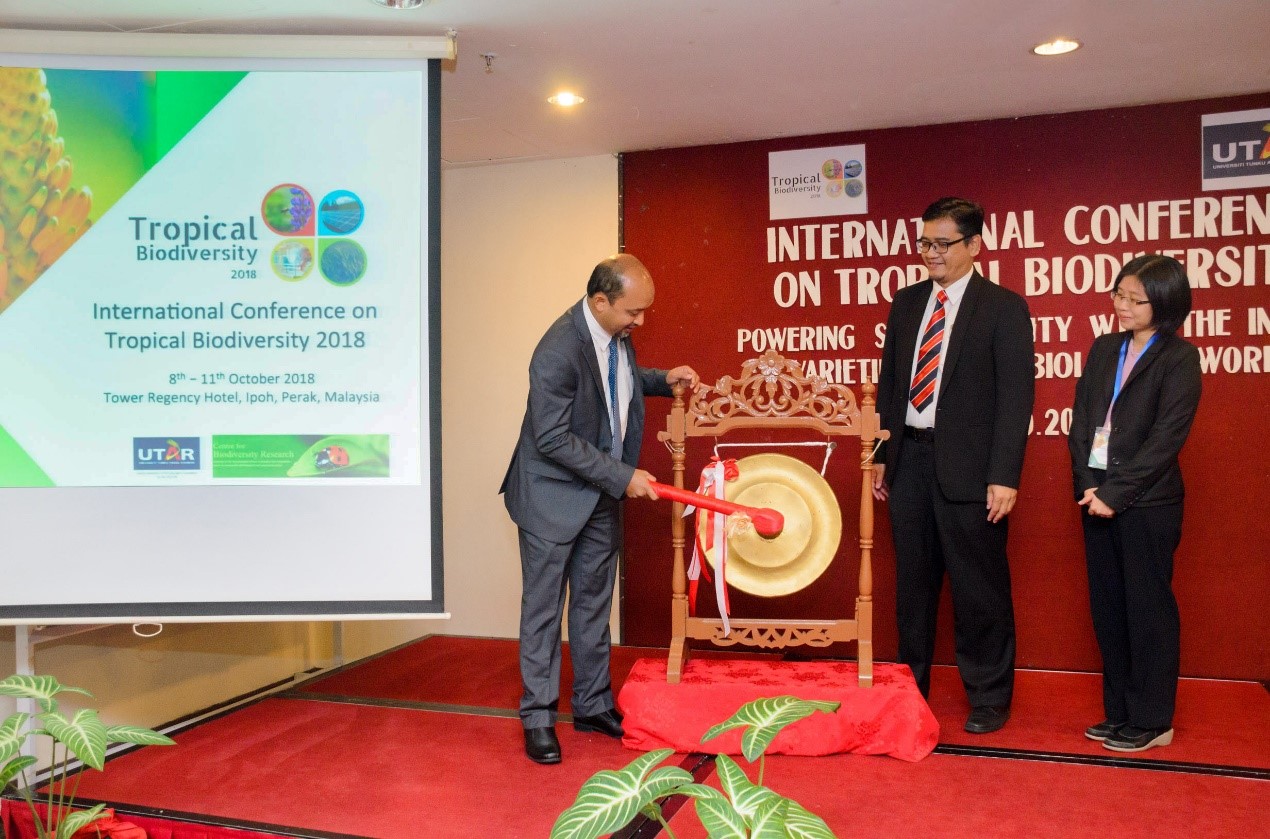
From left: Hizaz officiating the conference, while Prof Faidz and Dr Goh look on the right
Themed ‘Powering Sustainability with Infinite Varieties in Our Biological World’, the conference aimed to bring together the world’s experts to present and share their current findings, as well as to strengthen interdisciplinary research links among researchers and stakeholders by promoting effective communication on various current issues related to biodiversity. The conference consisted of three plenaries, seven keynotes and four symposiums. Each symposium discussed a specific sub-theme, which were ‘Fundamentals of Biodiversity’, ‘Sustainable Agriculture and Food Security’, ‘Biodiversity and Human Health’, and ‘Biodiversity in Modern Living’.
Enriching minds via plenary sessions
The first plenary saw Dato Sri Dr Gathorne-Hardy presenting his research titled “Swiftlets (Aves, Apodidae, Collocaliini) in Science and Society: Research in the Past Six Decades and Future Prospects”. He shed new light on the origin of the distinctive 'domesticated' phenotype now occupying house-farms. The unique features of this fascinating group of birds will continue to provide opportunities for enhanced cooperation between science and society.
His research explained that the swiftlets form a natural group, classed as 'tribe' Collocaliini within the typical swifts Apodidae, distributed at tropical or sub-tropical latitudes across the Indo-Pacific region from the Seychelles to Hawai'i, north to the eastern Himalayas in continental Asia, and south to northern Australia. A new industry has developed in the construction of purpose-built premises (called 'house-farms') and the management of swiftlets occupying them, often in urban environments. The expansion of house-farming has not prevented over-harvesting of nests in natural breeding sites which has seriously reduced many wild populations of swiftlets to local extermination. These developments represent a novel form of domestication of a bird, the first time that this process can be monitored scientifically. Beyond these obvious fields of economically and socially productive science, improved capabilities of molecular genetics have opened the door to ground-breaking research into the systematics and phylogeny of swiftlets, wild and domesticated.
Universiti Sains Malaysia (USM) academic Prof Dr Yuen Kah Hay presented the research titled “Neuroprotective properties of vitamin E tocotrienols from palm oil: Evidence from cell to animal and human studies”, at the second plenary. Prof Yuen’s research explained that crude palm oil is highly rich in phytonutrients, especially in vitamin E tocotrienols. Palm vitamin E tocotrienols have immense potential in the preventive management of such neurodegenerative disorders, and to provide opportunities for enhanced cooperation between science and society. Tocotrienols but not tocopherols, have been shown to possess neuroprotective properties. At nanomolar concentrations, alpha-tocotrienol was able to block glutamate induced neuronal cell death by modulating chemical signals within the neuronal cells. More recently, in a double-blind placebo controlled human study, it demonstrated that the tocotrienols could significantly attenuate the progression of brain white matter lesions (WMLs) compared to placebo. WMLs are abnormal hyperintense regions observed in MRI T2-weighted sequences of the brain. Often detected in elderly people, these lesions are attributed to pathological changes in the small blood vessels of the brain, leading to chronic hypoperfusion and ischemic damage in the white matter. They reflect a spectrum of neuropathological changes with tissue damage of varying severity. Recent studies have shown that WMLs are strongly associated with neurodegenerative diseases which give rise to cognitive dysfunction, dementia and Alzheimer’s disease.
The third plenary saw University of Greenwich, UK academic Dr Chan Jin Hooi presenting his research titled “Sustainable Innovation and Social Entrepreneur in Biodiversity Related Sectors”. Dr Chan highlighted the abundance of potential in using innovations in the knowledge pertaining to the environment and biodiversity. It is the businesses’ mission to challenge the current business world, and to initiate and facilitate behavioural changes of the general public leading to sustainable development. Social entrepreneurship is a movement well suited to this era with great social and environmental challenges. He also explained that an entrepreneur needs to combine the passion of a social/environmental mission but also need to operate in a business-like manner. Nonetheless, social entrepreneurship is a larger and more active movement particularly involving young people and technology. Social entrepreneurship involves new thinking, new types of organisations in both traditional and emerging sectors such as bio-resources related and conservation. The entrepreneurs need to challenge existing business models and also to think about new business models and practices. Innovations in business models and practices are essential, in addition to sustainable innovations in sciences and technologies.
Deepening understanding through Keynote sessions
At the first keynote session, University of Nottingham Malaysia academic Prof Dr Asgar Ali discussed the potential of advanced technologies in delaying ripening and extending postharvest life and reducing postharvest disease of tropical fruits and vegetables, through his research titled “The Role of Postharvest Technology in Achieving Food Security”. The research explained that, according to the United Nations, current world population is expected to reach 9 billion by the year 2050 and food production will have to increase by 70% to meet the food and nutrition needs of the rising population. One strategy for increasing the food available to feed the ever-increasing population is to ensure proper and better utilization of the food that is already produced. It is estimated that one third of the food produced for human consumption is lost or wasted along the supply chains from production to consumption stage globally. This translates into 1.3 billion metric tons of the total volume of the food produced. The Food and Agricultural Organization (FAO) reports that annual food losses and wastes (FLW) worldwide worth about US 2.6 trillion (including energy, water and workforce required), which is approximately 5% of the world GDP. The reduction of FLW is an important strategy to ensure food and nutritional security in efficient and sustainable food systems. Therefore, an urgent need exists for a concerted effort at national, regional, and global levels to reduce FLW. New technologies are being developed to prevent food waste - one of the most straightforward 'wins' to achieve global food supply. In developing countries, as much as half of harvested crops are lost between the field and consumer. Pilot scale studies are being carried out here in collaboration with industry to develop an edible coating technology.
The second keynote session saw Bogor Agricultural University, Indonesia academician Prof Dr Iskandar Z. Siregar discussing on the current progress on genetic studies (e.g. marker based and field trial based) of several promising forest tree species (e.g. dipterocarps and non-dipterocarps) and their practical implications to conservation management, silvicultural practices and other forms of utilization (i.e. breeding), through his research titled “Genetic Consideration and Sustainable Forest Management in the Tropics: Lessons Learned from Indonesia”. He explained that efforts to meet sustainability principles in tropical forest management require sufficient verified knowledge products on ecological and socio-economic aspects. Within the context of knowledge management cycle, the significant results on ecology and biodiversity research are necessary to be captured, documented, verified and finally adopted by the respective users (i.e. policy makers, practitioners and academician) in order to sustain the innovation in forestry sector. In Indonesia and other tropical countries, however, researchers often observed significant gaps in knowledge management to enhance the utilization of research outputs, particularly genetic research on priority forest tree species with significant ecological and socio-economic functions. In turn, this condition could lead to the ad-hoc policy formulation. Through long term research on various genetic aspects of priority tree species in Indonesia (e.g. genetic inventory, population genetics and breeding), the researchers attempt to interface between science and policy with various lessons learned.
Universiti Putra Malaysia academician Dr Chee Hui Yee presented her research titled “Genetic Diversity of Rhinovirus C3’ Non-coding Region” at the third keynote session. The aim of her research was to investigate the genetic diversity of RV-C 3’ non-coding region (NCR) which is involves in virus replication with respect to primary sequence (linear sequence) and secondary structure via bioinformatics analyses. She explained that respiratory disease is the most prevalent viral disease in humans and Rhinovirus (RV), Respiratory Syncytial Virus (RSV), Human Enterovirus (HEV) and Influenza Virus (IFV) are among those viruses causing respiratory tract infection. RVs have been reported to be one of the viruses that frequently associated with respiratory tract infections. There are 3 groups of RV, RV-A, RV-B and RV-C where RV-C has been reported in causing more critical illnesses and exacerbations of asthma. A similar domain Y was identified in RV-C primary sequences although pairwise similarity of these sequences demonstrated a huge difference. Each RV-C member showed a minimal conserved stem-loop secondary structure that derived from 3’ NCR sequence. Based on the numbers of loop (apical loop and interior loop) in secondary structure, a potential grouping of RV-C was suggested. A relative conserve motif, AUNUNNNA was identified in RV-C 3’ NCR, while UAG codon was frequently seen in the loop sequence of RV-C 3’ NCR secondary structure. Due to lack of disease severity information for sequences retrieved from Genbank, relationship of the suggested RV-C grouping in the present study and disease severity was not able to be elucidated. In turn, the current information will be able to provide additional insight for future study on the functional impact of sequence and structural differences of RV-C to illustrate the potential relationship of 3’ NCR sequences and disease severity.
Dr Ahimsa Campos-Arceiz from University of Nottingham Malaysia, at the fourth keynote session reflected about the learnings from almost 10 years of work of The Management & Ecology of Malaysian Elephants (MEME), an interdisciplinary project run as a collaboration between local wildlife authorities and university researchers that aims to bring an evidence-based approach to the conservation of Malaysian elephants, through his research titled “What Will It Take to Conserve Wild Elephants in Peninsular Malaysia”. Participants learnt that elephants and other megafauna play key and irreplaceable roles in ecosystem processes but, due to their high demand for resources and lack of natural predators, are maladapted to the current human-dominated world. For megafauna to survive beyond the bottleneck of the 21st century, business as usual is not an option and there is a need to find effective ways to coexist with them. Therefore, the research also listed a few key issues for the successful conservation of elephants in Peninsular Malaysia are: (1) to protect more elephant habitat as Protected Areas (PA), since less than 6% of Peninsular Malaysia is formally gazetted as a PA; (2) to promote connectivity between these PAs and other forest habitats, which would require the implementation of the existing Central Forest Spine (CFS) land-use Masterplan; (3) to mitigate human-elephant conflict, which is likely to increase as elephant habitat becomes more fragmented; and (4) need to reconsider Federal-State Government relationships in order to effectively achieve the three previous points.
Prof Dr Kang Ming, from South China Botanical Garden, China, with his research titled “Past Climatic Change as A Driver of Plant Diversification in the Karst Ecosystems from Southern China” demonstrated that past monsoon activity is positively correlated with speciation rate in East Asia. The case study could also motivate further investigations to assess the impacts of past environmental changes on the origin and diversification of biodiversity in global karst ecosystems, most of which are under threat. In depth, the research explained that Karst ecosystems in southern China are species-rich and have high levels of endemism, yet little is known regarding the evolutionary processes responsible for the origin and diversification of karst biodiversity. The genus Primulina (Gesneriaceae) comprises ca. 170 species endemic to southern China with high levels of ecological (edaphic) specialization, providing an exceptional model to study the plant diversification in karsts. We used molecular data from 20 regions (9 chloroplast and 11 nuclear) and macro evolutionary analyses to assess the origin and cause of species diversification due to paleo environmental changes and edaphic specialization in Primulina. We found that speciation was positively associated with changes in past temperatures and East Asian monsoons through the evolutionary history of Primulina. The climatic change around the mid-Miocene triggered an early burst followed by a slowdown of diversification rate towards the present with the climate cooling. The researchers also detected different speciation rates among edaphic types, and transitions among soil types were infrequently and did not impact the overall speciation rate. Findings suggest that both global temperature changes and East Asian monsoons have played crucial roles in the floristic diversification within the karst ecosystems in southern China, such that speciation was higher when climate was warmer and wetter.
Dr Alice Catherine Hughes from the Chinese Academy of Sciences, China presented at the sixth keynote session, with her research titled “Biodiversity Threats in the Asian Tropics”. Her research explored the main threats to the regions biodiversity, evaluating their relative impact and exploring the prognosis for different parts of the region. Much of Asia has reached a point of almost no return with much of its native biodiversity, with rates of undocumented road building in many parts of the region (i.e. 90% or roads in central Kalimantan are unmapped) symptomatic of the rapid rates of deforestation, and the rapid exploitation of native resources and species in these regions. The research also explored the various threats to the regions biodiversity, and discussed which ecosystems, species and regions are most at risk. She also discussed priorities for action and implementation using various approaches, and the major barriers to implementing the necessary policy and management protocols to secure a future for the regions biodiversity. Dr Alice also discussed the relative responsibilities of the West, as the end-buyers of many products and the role of intergovernmental agreements in trying to enforce various regulations (i.e. SDGs, Aichi targets) to try to change the trajectory of this region, and its threatened biota.
Meanwhile from UTAR, Prof Peter Ooi Aun Chuan, with his research titled “Rich Biodiversity Helps Keep Invasive Insects from Becoming Serious Pest Problems” discussed how recent invasive insect pests are kept in check in Malaysia at the seventh keynote session. His research explained that insect pests from native oil palms quickly transferred to the newly introduced oil palm from Cameroons. However, it was soon found that the natural enemies, one of four agro-biodiversity components that kept the insects in check as they did so on native palms. There were some evidence on the role of agro-biodiversity in keeping insect pests of oil palm in check. These fortuitous biological controls were studied with the invasive pests Aleyrodicusdispersus and Heteropsyllacubana. Studies showed that native coccinellids fed on these invasive pests and their impacts were reduced as a result.
Engaging the public through forum
A public forum titled “Conservation of Biodiversity, A Way Forward for Better Life”, was also held on the second day of the conference. The panellists were Dato Sri Dr Gathorne-Hardy, Dr Chan Ji Hooi and Dr Ahimsa Campos-Arceiz, along with moderator Dr Daniel Baskaran. Dato Sri Dr Gathorne-Hardy enlightened participants on ways of approaching policy makers, and ways to influence policy makers in order to get the message out. Meanwhile, Dr Ahmisa shed light on the need to protect megafauna, like elephants, because megafauna is important for forest conservation. Graphs and charts were also used to support the need for conservation of megafauna.
Dr Chan asked the participants “What can we contribute as individuals?” and explained on sustainable socio-technical transitions. He also mentioned that sustainable innovation, a process where sustainability considerations (environmental, social, and financial) are integrated into company systems from idea generation through to research and development, and commercialisation, is very much focused in the present time. He used the example of conservationist using the virtual reality (VR) technology to enable the public to see the beauty of the Amazon forest, and help encouraged sustainable efforts from public. The Q&A session also led to interesting discussions on matters, such as management of resources; the need for improving quality of life and managing human consumption; and education method to encourage participants from the younger generation in conservation efforts.
Industrial experts were also present for the industrial talk, which included Orbiting Scientific and Technology Sdn Bhd on “Mercury Analysis and Danger of Mercury Poisoning”; Matrix Optics (M) Sdn Bhd on “Digital Microscopy”; Ligno Biotech Sdn Bhd on “Tapping into Malaysian Biodiversity”; and Hi Tech Instruments Sdn Bhd on “Low kV High Resolution Transmission Electron Microscopy”.
“I enjoyed this conference, particularly on the note that I have gained more information on molecular genetics, forest species and tropical species, which will be very helpful for my current research projects,” commented Amaliena Ahmad, from UniKL MICET, Malacca.
Meanwhile, Miera Rozman and Hanis Syafiqah from UniKL MICET mentioned that they received feedback to improve their researches, and meeting other researchers at the conference had enabled them to get research assistance as well as forging potential collaborations.
The closing ceremony, held on 10 October 2018, marked the end of the conference. Present at the conference were Faculty of Science Dean Assoc Prof Dr Lim Tuck Meng and Director of South China Botanical Garden Prof Dr Wang Ying, organising committee, speakers and participants.
“I am very grateful to the local organisers for organising this conference. Without the local support, we would not be here. Altogether from China, 12 delegates participated in this conference. We are indeed happy because we were able to explore the rich biodiversity of Perak. This conference is truly a good platform for an exchange of knowledge and for building meaningful friendships. More so, we are able to extend our networks with UTAR and other local researchers,” said Prof Wang Ying.
Meanwhile, Dr Lim, in his speech commented, “The three-day discussion on various aspects of tropical biodiversity has opened up avenues for future actions and collaborations in a new network. In the pursuit and competition of development many precious ecosystems have been destroyed out of human greed, selfishness and ignorance. The perpetrators have forgotten that we share the planet with other living things, who have the equal right to survive. A break in the chain of life will trigger a domino effect, which may not be immediate or conspicuous. We must fulfil our duty; the trust inherited from our ancestors to protect the environment, and eventually pass down to future generations, hopefully in a better condition.”
Dr Lim continued, “Though the conference ends today, moving forward from here, we should make concerted efforts to influence those around us, not restricted to politicians, about conservation and protection of the environment and its biodiversity. I also take this opportunity to thank the organising committee for their hard work in making this gathering possible. They have worked for two years in preparing for this conference. I also thank the sponsors who have supported this event financially. Thank you to the participants as well, for sharing your enthusiasm at this conference.”
|
| 4 |
Bilateral Symposium spurs R&D collaborations
Venue and Date: UTAR Kampar Campus, 8th October 2018.
Venue and Date: Sg. Long Campus, 10th October 2018.

Third from left: Prof Ewe, Dr Chern, Dr Lim, researchers, academics and participants at Kampar Campus
An inaugural bilateral symposium between UTAR and Academia Sinica (AS), Taiwan, was held at Kampar Campus on 8 October and then at Sungai Long Campus on 10 October focusing on Physical Science, Life Science and Medical.
Jointly organised by the Faculty of Science (FSc) and AS, the symposium at Kampar Campus saw the coming together of over 20 prolific researchers from both Taiwan and Malaysia to share their insights and latest findings in the areas of Physical Science and Life Science.
Led by the Director and Distinguished Fellow of AS Dr Chern Yi-Juang, the AS delegation was welcomed by UTAR Vice President for Internationalisation and Academic Development Prof Ir Dr Ewe Hong Tat, FSc Dean Assoc Prof Dr Lim Tuck Meng and Division of Community and International Networking (DCInterNet) Deputy Director Dr Chen I-Chi.
Introducing UTAR as a fast-growing university, offering quality yet affordable education and encouraging R&D activities which will benefit the society, Prof Ewe mentioned the university is, therefore, more than honoured to be hosting the symposium so as to promote mutual learning and collaboration. Adding that UTAR has had strong and long-standing ties with over 50 universities in Taiwan, Prof Ewe said, “UTAR has been working hard in international collaborations. Such international collaboration will enhance staff and students’ international exposure and we believe that the research areas of science, technology and medicine are very important following the advent of the Fourth Industrial Revolution. Currently, UTAR has over 1,300 academics who are involved in R&D and we have 32 research centres covering the fields of engineering, information technology, science, medicine, business, finance, and arts and social science. To support the R&D initiatives, we also allocate annual internal research funding through the UTAR Research Fund (UTARRF) and also encourage academics to work with other researchers, like all of you from AS as well as from other institutions.”
Expressing her appreciation to UTAR for the warm hospitality, Dr Chern also extended her invitation to UTAR and the local researchers to visit AS. “AS was established in 1928 and is Taiwan’s highest academic research institution with the mission to enhance research capacities in the humanities and sciences. We also conduct, promote and facilitate scholarly research so as to cultivate outstanding academic talent,” she explained. Besides introducing AS’s diverse international community of over 770 international scholars, the Biomedical Science expert also presented the available AS research mobility programmes such as the Short-Term Visiting Programme from and to AS, Postdoctoral Fellowship Programmes, Taiwan International Graduate Programme (TIGP), joint PhD supervision programmes and TIGP Summer International Internship Programme.

Prof Ewe (left) and Dr Chern (right) both expressing keen interests for potential research collaborations between UTAR and AS
The symposium also saw Dr Chern delivering her keynote lecture titled “Adenosine Augmentation Evoked by an ENT1 Inhibitor Improves Memory Impairment and Neuronal Plasticity in a Mouse Model (APP/PS1) of Alzheimer’s Disease” before the parallel sessions on Physical Science and Life Science.

Dr Chern shedding light on her study which provides a potential therapeutic strategy to delay Alzheimer’s disease progression
Among the line-up of AS researchers who shared their rich breadth of expertise during the parallel sessions included the Institute of Chemistry’s Dr Ong Tiow Gan and Dr Chen Chin-Ti; Institute of Molecular Biology’s Dr Chang Wen and Dr Chien Cheng-Ting; Institute of Biomedical Sciences’ Dr Lin Jung-Hsin and Dr Chen Chien-Chang; Institute of Physics’ Dr Chen Chii-Dong, Institute of Biological Chemistry’s Dr Lin Chung-Hung, Institute of Plant and Microbial Biology’s Dr Ma Lay Sun, Institute of Information Science’s Dr Su Li, Institute of Cellular and Organismic Biology Dr Kuo Hung-Chih and Biodiversity Research Center’s Dr Chiu Chin-Yu.
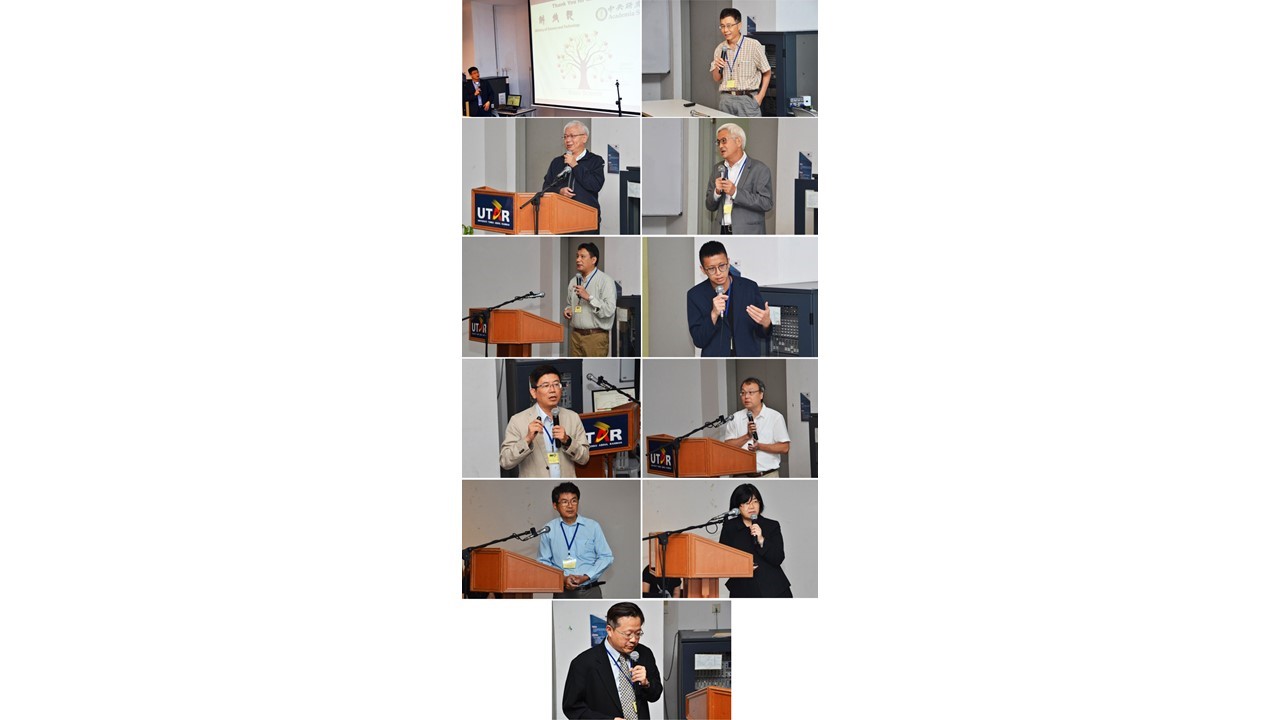
AS academics imparting their knowledge (clockwise from top left): Dr Ong, Dr Chen Chii-Dong, Dr Chen Chin-Ti, Dr Su, Dr Kuo, Dr Chang, Dr Lin Chun-Hung, Dr Chiu, Dr Chen Chien-Chang, Dr Lin Jung-Hsin and Dr Chien
The academics from local institutions of higher learning who also shared their research findings included UTAR’s Prof Dr Minoru Murata, Assoc Prof Dr Sim Yoke Leng, Assoc Prof Dr Wong Hann Ling, Dr Ng Soo Ai, Dr Mohammod Aminuzzaman, Dr Kuan Chee Hao and Dr Yap Moh Lan; Universiti Sains Malaysia’s Prof Dr Lim Jit Kang, Assoc Prof Dr Yeoh Fei Yee, Dr Lee Hooi Ling; Universiti Malaya’s Assoc Prof Dr Vannajan Sanghiran Lee and Universiti Kebangsaan Malaysia’s Prof Dr Norazlina Mohamed.

Academics of Malaysian universities presenting their findings (clockwise from top left): Prof Lim, Prof Murata, Dr Yeoh, Dr Kuan, Dr Lee, Dr Mohammod Aminuzzaman, Dr Wong, Prof Norazlina, Dr Vannajan and Dr Yap
Reminiscing the first encounter and engagement with AS early this year, Dr Lim in his closing remark thanked the relevant parties who have brought both UTAR and AS together which eventually brought about the symposium. “It is because of your effort and interest that this symposium is made possible. FSc plays just a small part in providing an avenue for different people to meet and know the interests as well as the works of others so that there will be better collaborations,” said Dr Lim, who also mentioned that UTAR welcomes any parties who would like to collaborate to help advance knowledge and technology for the benefit of all. “Hope that with whatever knowledge that we gain today, the good memory and new friendships made, we will take this back home and work together for a better future,” he concluded.
The AS delegates were thereafter also invited to tour FSc’s laboratories.

Dr Chern (left) presenting a souvenir to Dr Lim as a gesture of gratitude to FSc

Dr Lim (left) introducing Faculty of Science, its laboratories and facilities to the AS delegates
The Medical-themed symposium was subsequently held at Sungai Long Campus on 10 October, where 12 researchers from both UTAR and AS presented their research papers covering a wide range of topics such as drug discovery, cardioprotection, extrachromosomal telomere DNA and alternative lengthening of telomeres cancer development, induced pluripotent and spheroidal stem cells. At the symposium, opening remarks were given from R&D and Postgraduate Programmes Deputy Dean Prof Dr Yap Sook Fan on behalf of FMHS Dean Emeritus Prof Dr Cheong Soon Keng and Dr Chern, with a brief introduction of the institute’s programmes and faculties respectively.

Academics from UTAR presenting their findings (clockwise from top left): Prof Lim, Prof Ong, Dr Leong, Prof Choo and Looi
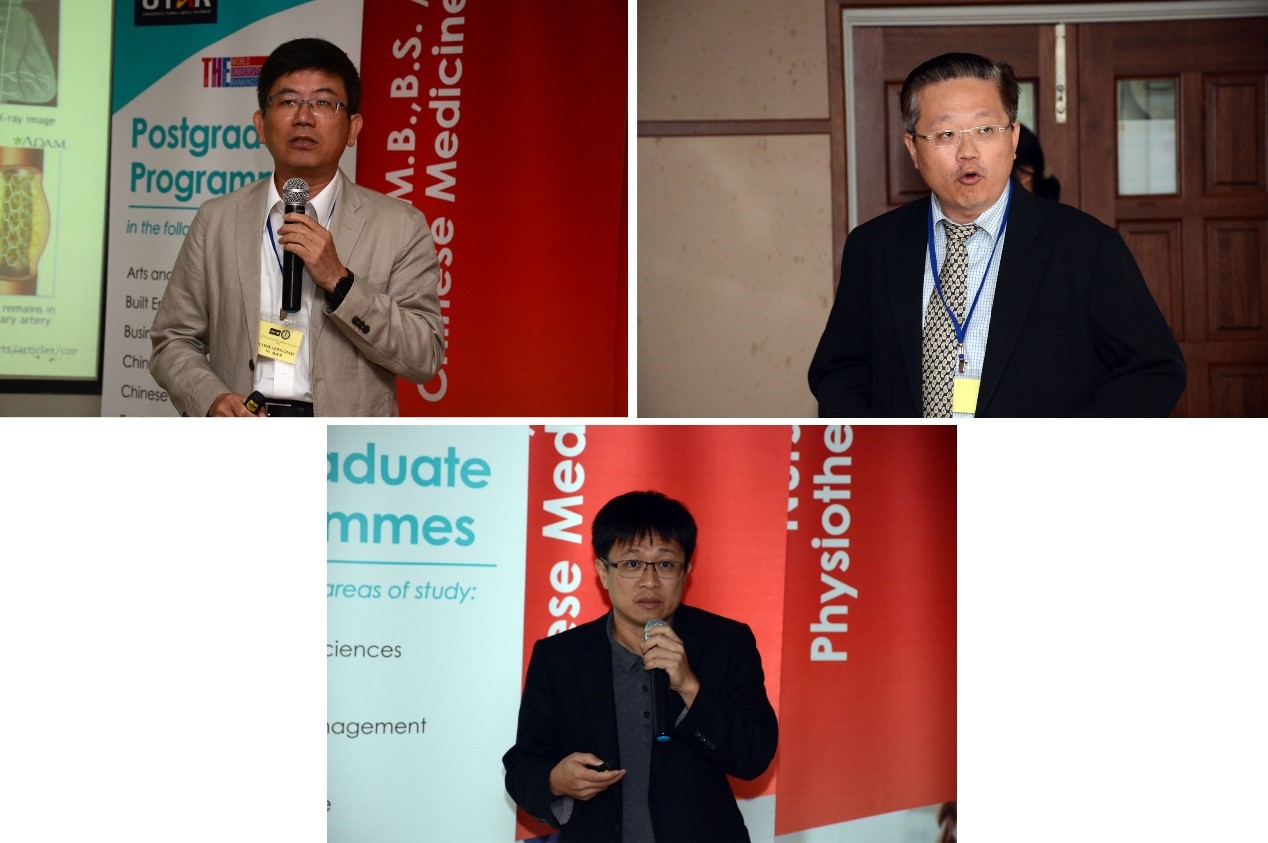
Academics from UTAR presenting their findings (clockwise from top left): Prof Lim, Prof Ong, Dr Leong, Prof Choo and Looi
The symposium also saw a lively exchange of opinions and perspectives among researchers. UTAR Centre for Stem Cell Research Chairperson-cum-Student Development and Industrial Training Deputy Dean Prof Dr Alan Ong Han Kiat, Centre for Cancer Research Chairperson-cum-Postgraduate Programmes Head Prof Dr Lim Yang Mooi, Department of Pre-clinical Sciences Head Dr Leong Pooi Pooi, FMHS Academic Prof Dr Choo Kong Bung and doctoral student Looi Hong Keat were among those contributors to the sessions. While AS researchers were Dr Chern, Dr Kuo, Dr Chien, Institute of Biological Chemistry’s Dr Lin Chun-Hung, Institute of Molecular Biology’s Dr Chen Liuh-Yow, Institute of Biomedical Sciences’ Dr Lin Jung-Hsin and Dr Chen Chien-Chang.
Giving his closing remarks at the symposium, UTAR Vice President for R&D and Commercialisation Prof Ts Dr Faidz bin Abd Rahman expressed his gratitude to the researchers for sharing their valuable research work at the symposium. He mentioned that the aim of the symposium was to provide the researchers with a platform for disseminating research findings, sharing contemporary knowledge and building networks and collaborations to advance research and thereby contribute to both institutes. He also expressed his hope that more research collaborations could be established at the inter-institutional and cross-country levels, and he is looking forward to have a productive and formal relationship between both institutions.
A meeting was subsequently held after the seminar, with the participation of delegates from both UTAR and AS. Headed by Prof Faidz and Dr Chern, both parties carried out a discussion on means of cooperation, in which they exchanged ideas and opinions as well as discussed the resources available at both institutions. Various issues and some possible collaborations were brought up at the meeting, including short-term visiting programme, TGIP summer international internship programme, short courses for UTAR undergraduate research scheme at AS, and joint supervision for postgraduate programmes. The meeting also included a discussion on the direction and the possibilities of the memorandum of understanding (MoU) between UTAR and AS with a view to formalising and strengthening the relationship between both institutions.
UTAR previously signed its first MoU with the Center for Asia-Pacific Area Studies (CAPAS) of AS in 2009. The MoU aimed to explore areas of potential collaboration which paved ways for scholarships, dissemination of knowledge to the Asia-Pacific region, and sharing of expertise. Under the same MoU, mutual visits by faculty members were also facilitated for the purpose of enhancing efforts in pursuing research, teaching and for them to participate in seminars, conferences, and workshops. Academic collaborations were also extended through the study visits and student exchanges of postgraduate and undergraduate students. UTAR has also been actively sending publications to AS in hopes of spurring potential researchers to collaborate with one another. Such collaborative ties with CAPAS AS were strengthened further in an MoU renewal in 2015.
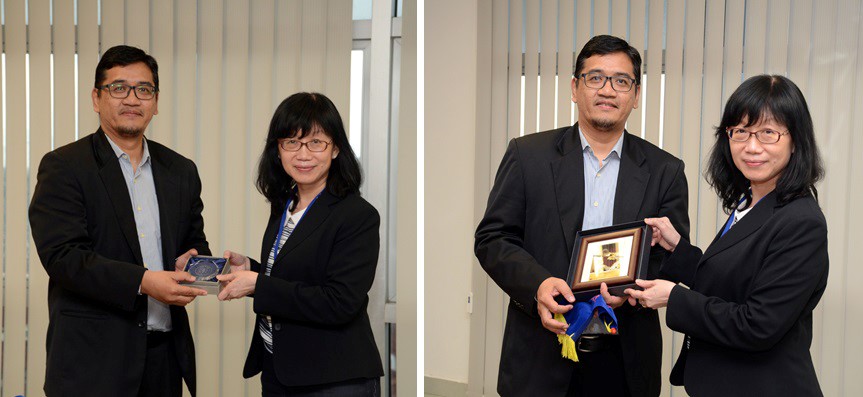
Souvenir exchange between Prof Faidz and Dr Chern (far right) after the meeting
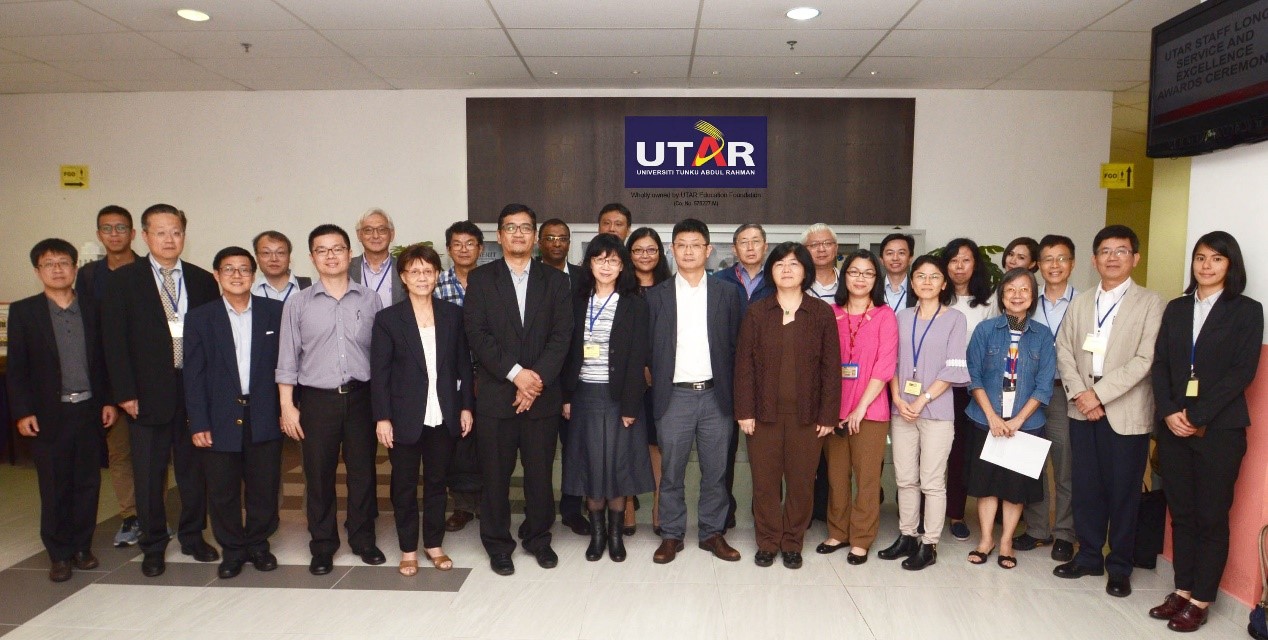
Prof Faidz (front row, sixth from left) and Dr Chern (seventh from left) with all the delegates
|
| 5 |
Inaugural Multidisciplinary Conference on Science and Humanities
Venue: UTAR, Kampar Campus
Date: 26 October 2018
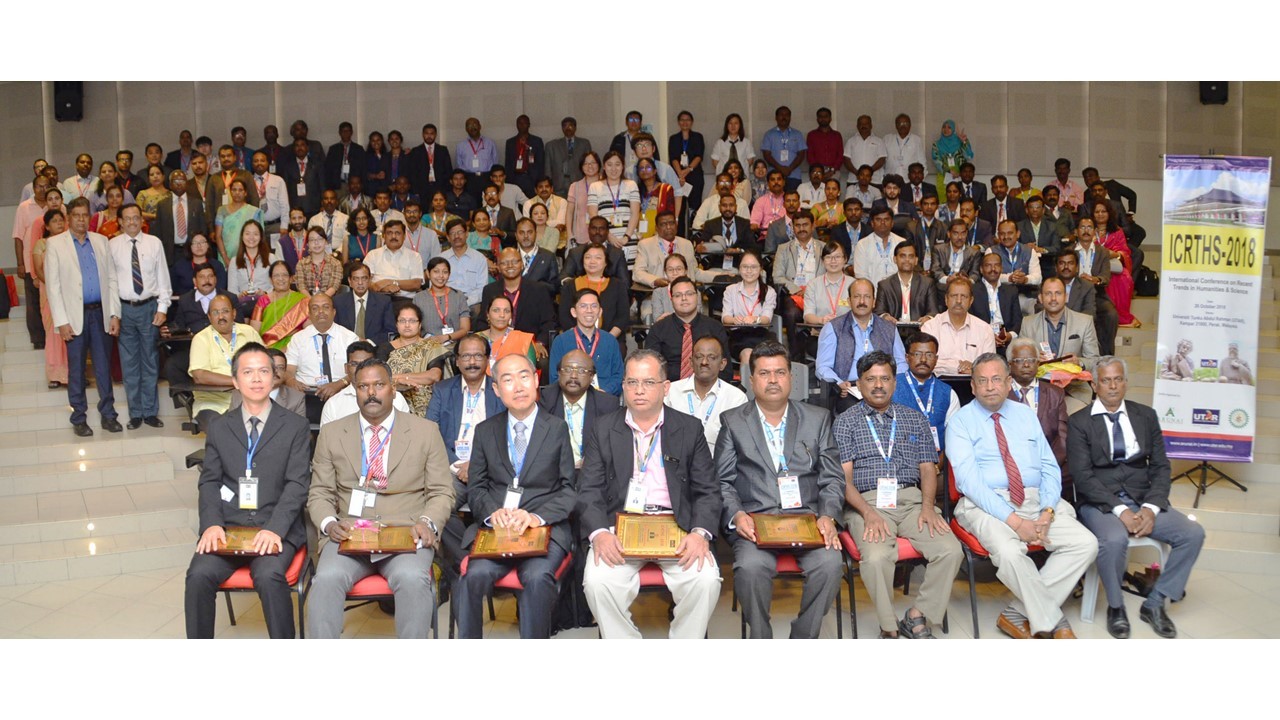
From left: Dr Wong, Sinouvassane, Dr Lim, Prof Mahadeva, Dr Sivachithappa, researchers, academics and participants at Kampar Campus
The one-day conference was jointly organised with Haldia Institute of Technology and Arunai International Research Foundation from India. It saw the presence of over 150 participants from 27 Indian higher learning institutions and nine Malaysian universities.
Held for the first time in UTAR, the conference served as a strategic platform, enabling participants to share experiences and insights in the areas of university-university collaboration.
Invited to officiate the conference was FSc's Dean Assoc Prof Dr Lim Tuck Meng, Professor from the Faculty of Medicine of Universiti Sultan Zainal Abidin, Terengganu Prof Dr U. S. Mahadeva Rao, Conference Chairman of the University of Mysore, India Dr K. Sivachithappa, Former Vice-Chancellor of Tamil Nadu Phy. Edu. Sports University Prof Dr R. Thirumalaisamy, FSc’s Centre for Biodiversity Research Chairperson Dr Wong Wey Lim, Organising Chairperson of ICRTHS 2018 D. Sinouvassane, participants, UTAR staff and students.
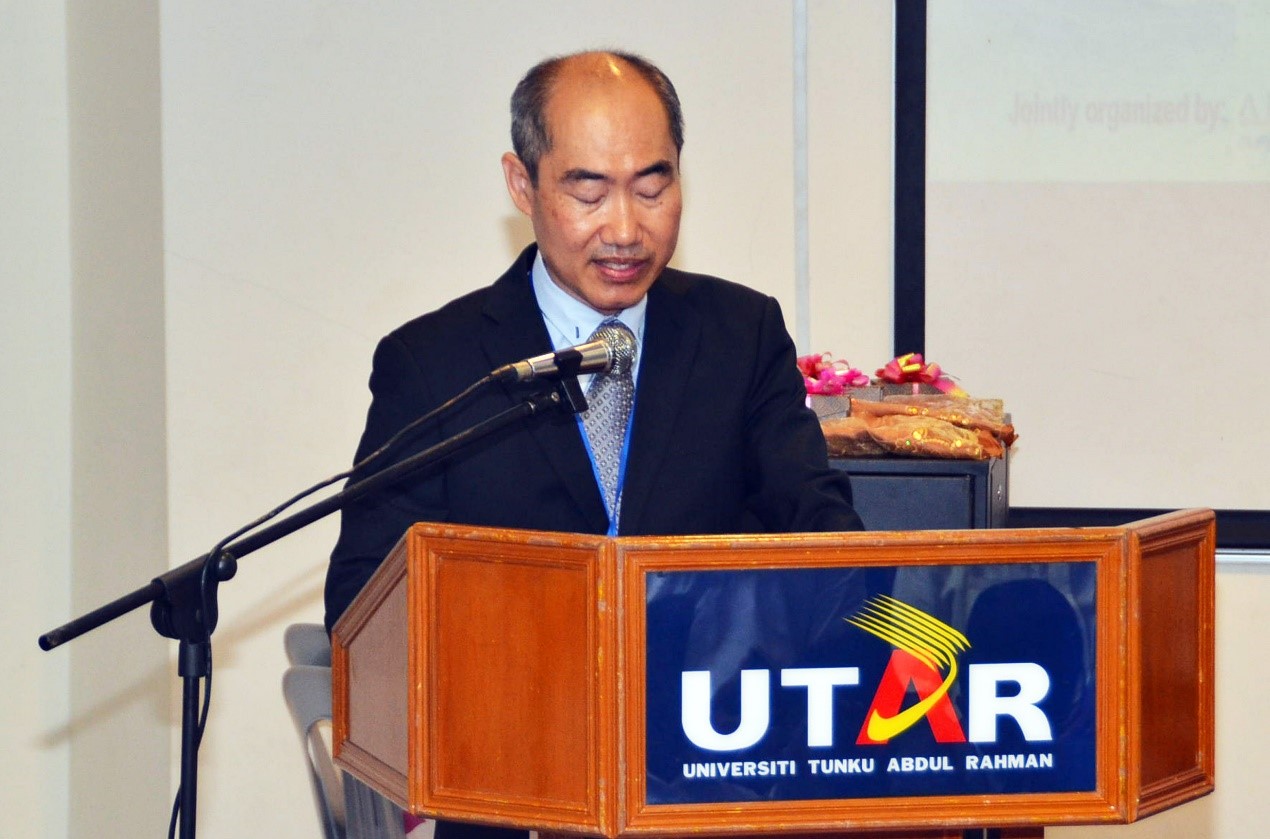
Dr Lim expressing keen interests for potential research collaborations between UTAR and Indian universities
Representing the Malaysian Organising Committee to deliver the welcome address was Dr Lim, who expressed his warm welcome to all the local and international participants at the conference. “The rapid development of knowledge and technology has precluded the model of ancient sages who claimed to know everything under the sun. Human beings have learnt that collaboration, communication and sharing of knowledge are the essence of sustainable future development. Hence, we see more and more congregations of minds to look into the human challenges from concerted efforts involving diverse disciplines,” he said, and hoped that ICRTHS 2018 will generate strategic networking between Malaysian and Indian academics.
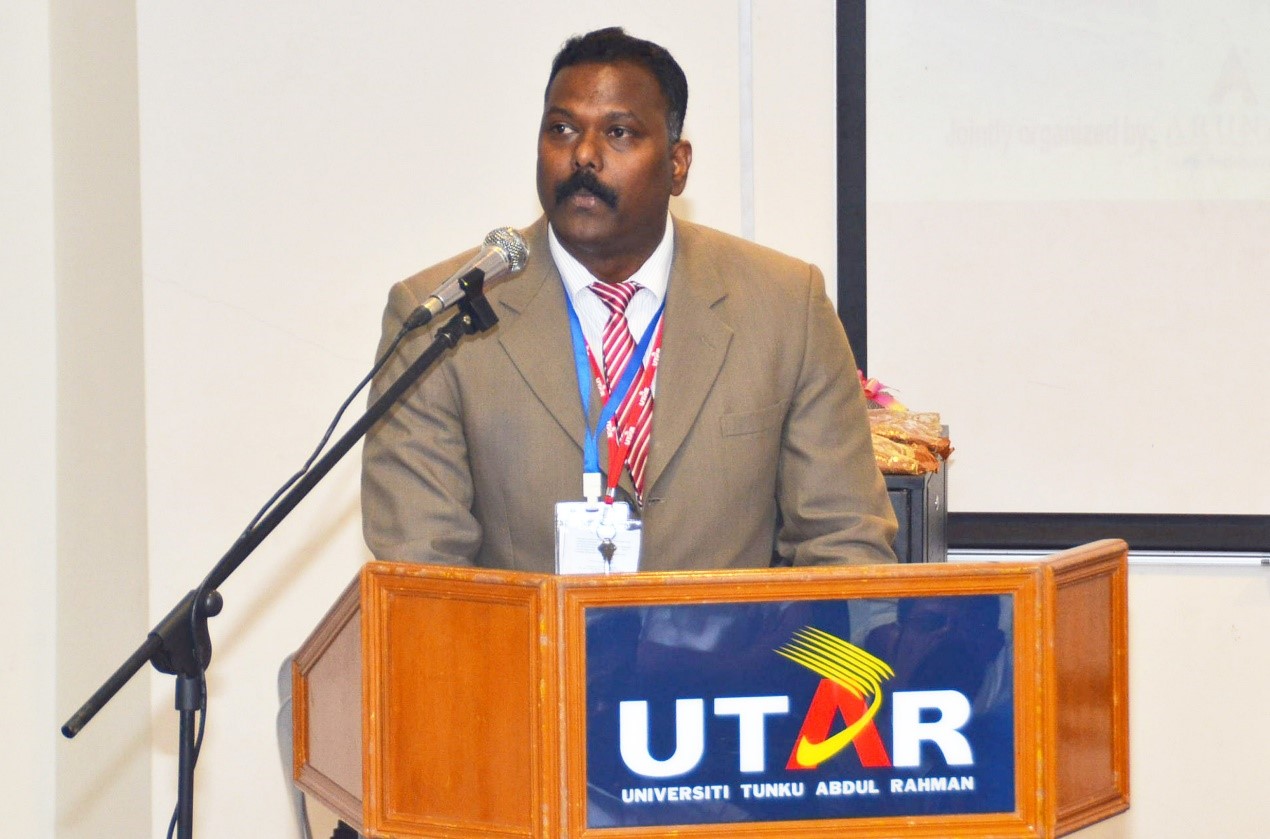
Sinouvassane explaining the key objectives of the conference
The Organising Chairperson of ICRTHS 2018, Sinouvassane said, “On behalf of the organising committee, it is our prodigious honour to invite and welcome you to the International Conference on Recent Trends in Humanities and Science 2018. This conference aimed at providing a platform for academicians, experts, scientists and research scholars from various disciplines of science and humanities to exchange the knowledge and ideas at most diverse and contemporary levels to buttress the academics and industry for the benefit of society. As the chairperson of the organising committee, I would like to thank the distinguished invited speakers for sharing their treasured knowledge and all the presenters for sharing their scientific novel as well as innovative findings. I am also indebted to all the members of the organising committee for their obligation and meticulousness to make this event memorable and successful.”
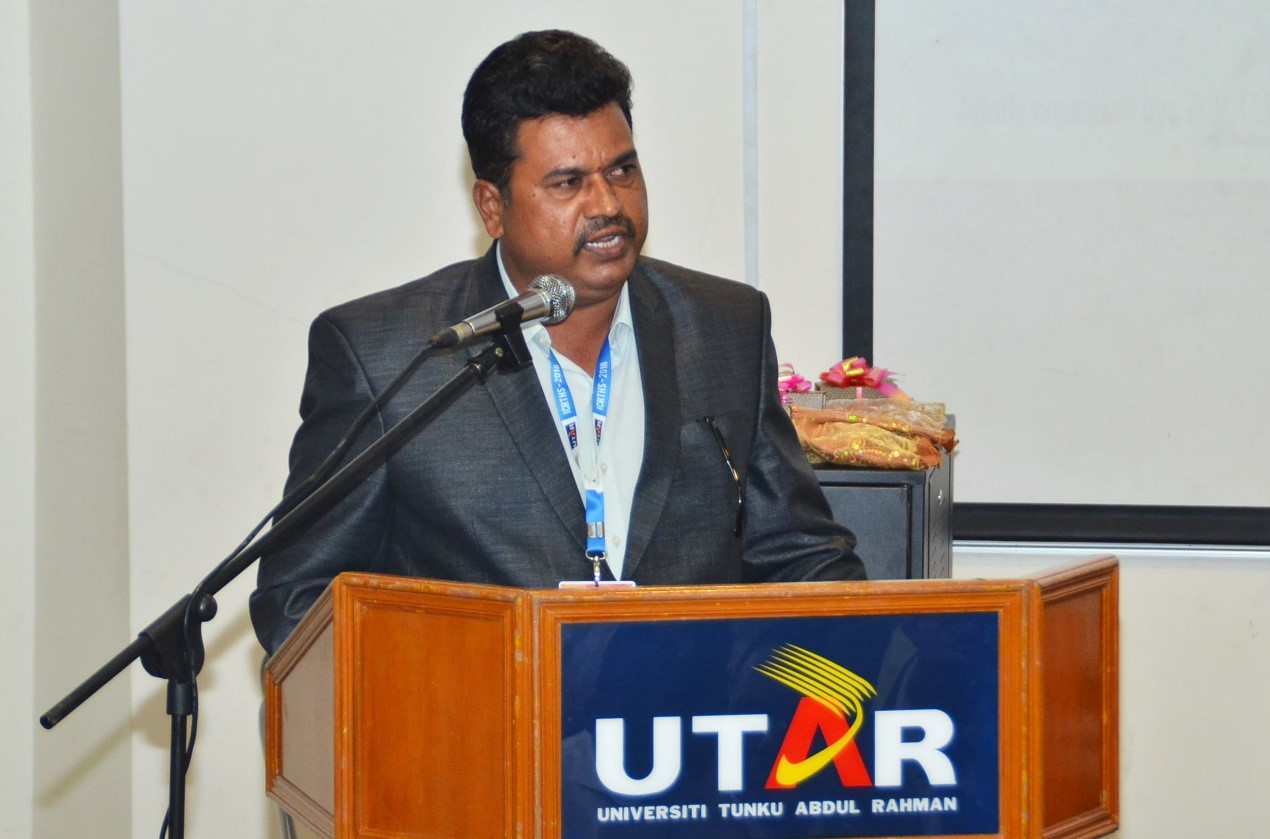
Dr Sivachithappa emphasising on the importance of humanistic knowledge
Conference Chairman from the University of Mysore, India, Dr Sivachithappa said, “Multidisciplinary research at present context is very much significant. Many of us have to constantly prove that research in education, literature, philosophy, history or sociology is just as important as anything else. Today, humanistic knowledge continues to provide the ideal foundation for exploring and understanding the human experience. In this context, the present conference will be very much useful to research scholars, academicians and policy makers.”

Prof Mahadeva emphasising on the importance of interdisciplinary research
Speaking on behalf of the Malaysian public university, Prof Mahadeva said, “Undeniably, it is becoming more and more obvious that major research funding agencies are progressively focused on concrete interdisciplinary association. As science gets more complex, interdisciplinary and socially potent, it gradually bears on areas traditionally occupied by the humanities; but it also with time, needs the reflective understanding that philosophy can provide. Within the themes of biology, medicine, psychology and philosophy, researchers can address questions regarding fact and value, knowledge and expertise, and individual and society as they arise at the intersection of the humanities and the life sciences.”

Prof Thirumalaisamy looking forward to various research collaborations with Malaysian universities
In his felicitation, Prof Thirumalaisamy enthused, “It is great to organise an appropriate international conference with the collaboration of UTAR. Indian youths are welcomed all over the world for their deep knowledge in their subject and sharp acumen, but we also need young generation with nerves of steel and muscles of iron to meet the international challenges and bring laurels and wards to India. I am sure that this conference will help to prepare the great achievers and awardees of tomorrow to meet the challenges in the global arena and to spot out and nurture the talents in youth and make them great achievers.”
The ceremony ensued with a souvenir presentation and group photograph session, followed by keynote addresses by two keynote speakers, namely Assoc Prof Dr Siah Poh Chuah from UTAR’s Faculty of Arts and Social Science and Assist Prof Dr Lee Poh Foong from UTAR’s Lee Kong Chian Faculty of Engineering and Science. They delivered significant keynote addresses titled “The Psychosocial Impact of Cultural Preference for Sons” and “A Quantitative Study on the Physiological Changes and Effects of Different Deep Breathing Durations on Cognitive Control” respectively.
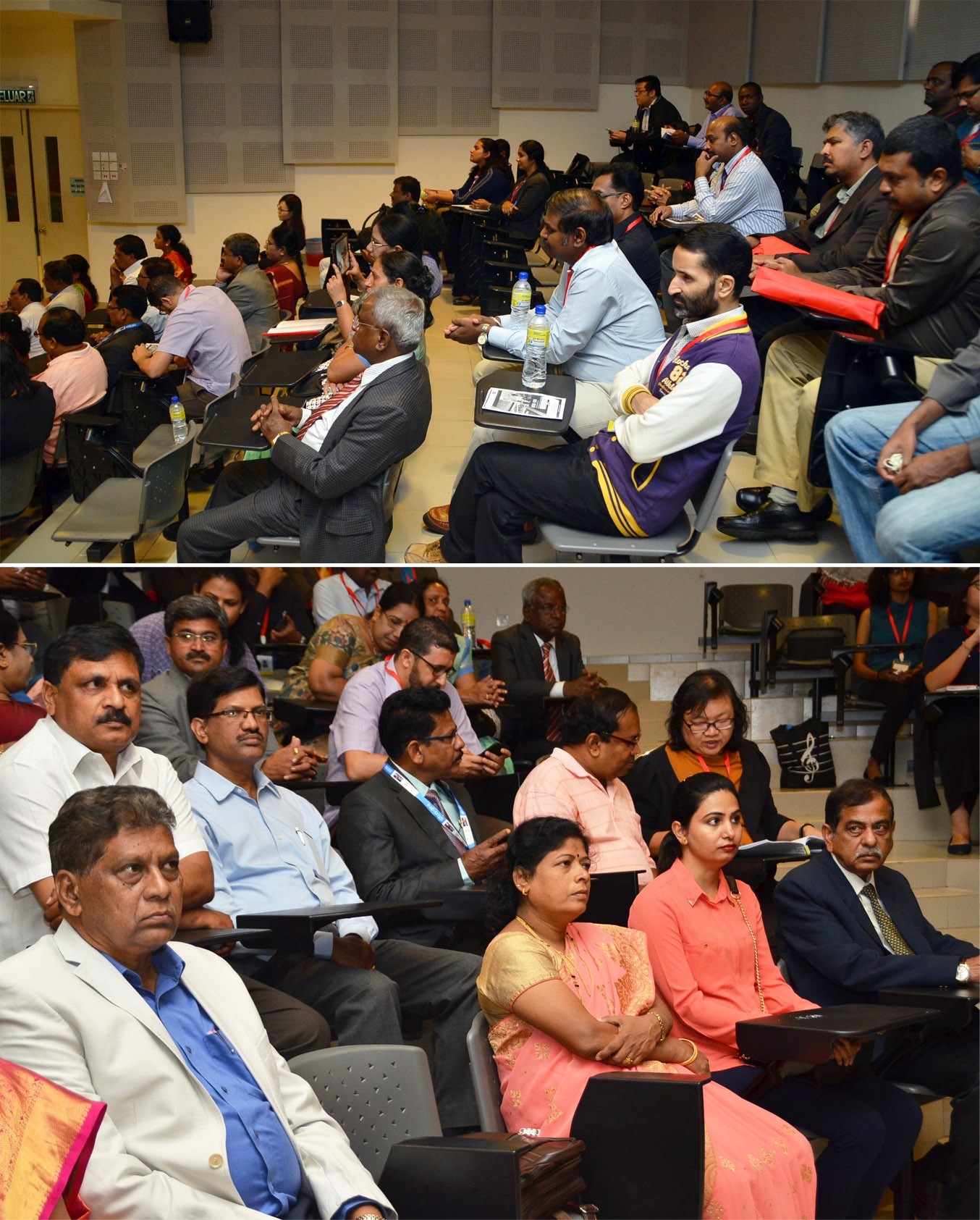
Attentive participants during the opening ceremony of ICRTHS 2018
Aimed to promote research and development activities in all branches of humanities and science, and to promote scientific information interchange between researchers, developers, students and practitioners working in India and Malaysia, the conference hosted two plenary lectures and nearly 120 oral and poster presentations presented by the researchers from India and Malaysia. The conference saw the participation of around 150 local and international participants.
Among the sub-themes presented throughout the conference were Medical, Health and Life Sciences, Mathematics and Information Technology, Education, Business and Social Sciences.
The selected abstracts of ICRTHS 2018 will be published in the American Journal of Biopharmacology Biochemistry and Life Sciences (online ISSN:2166-126X) in the following edition.
|





































